标签:des cPage style blog http color io os 使用
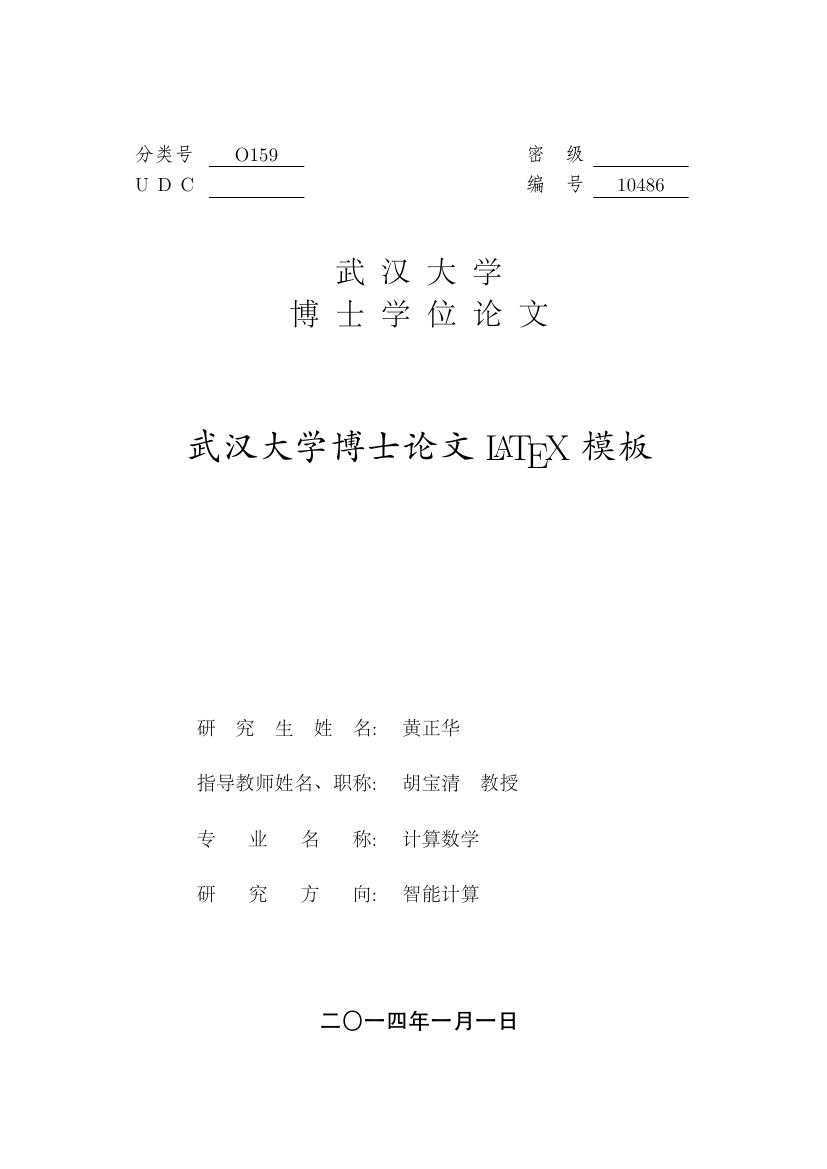

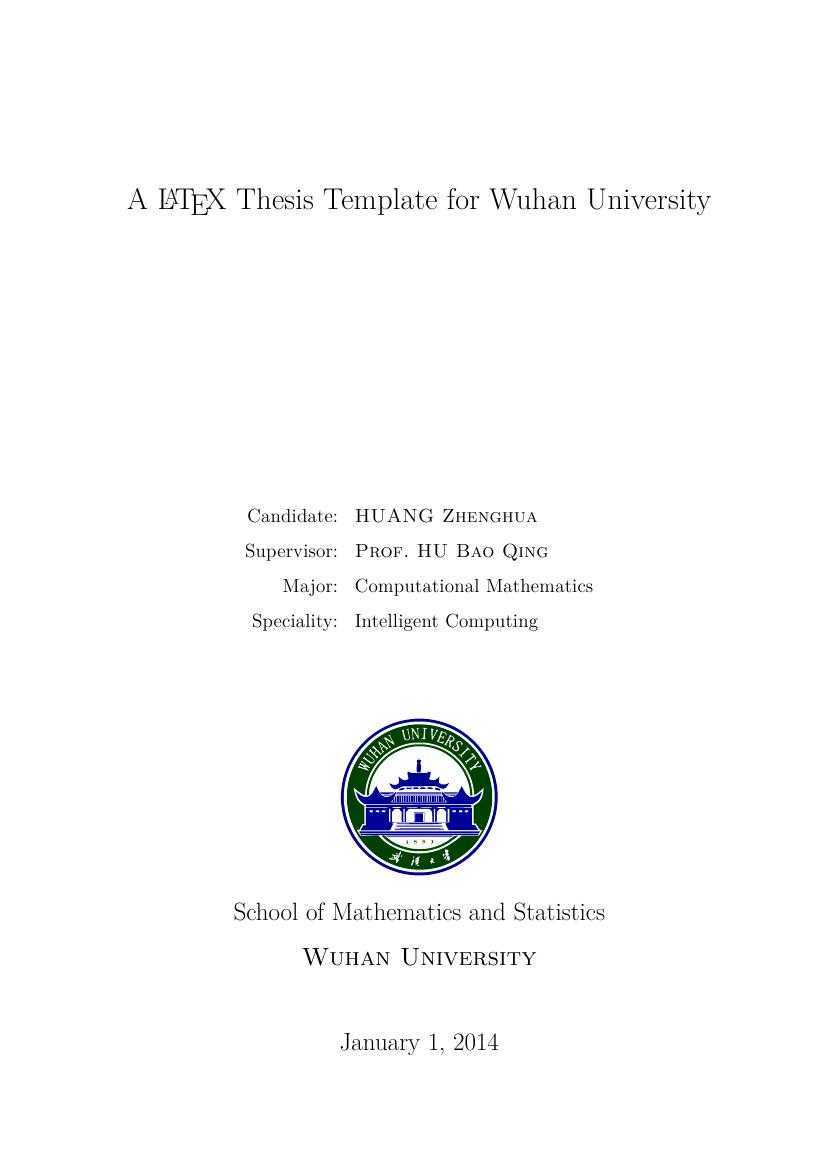



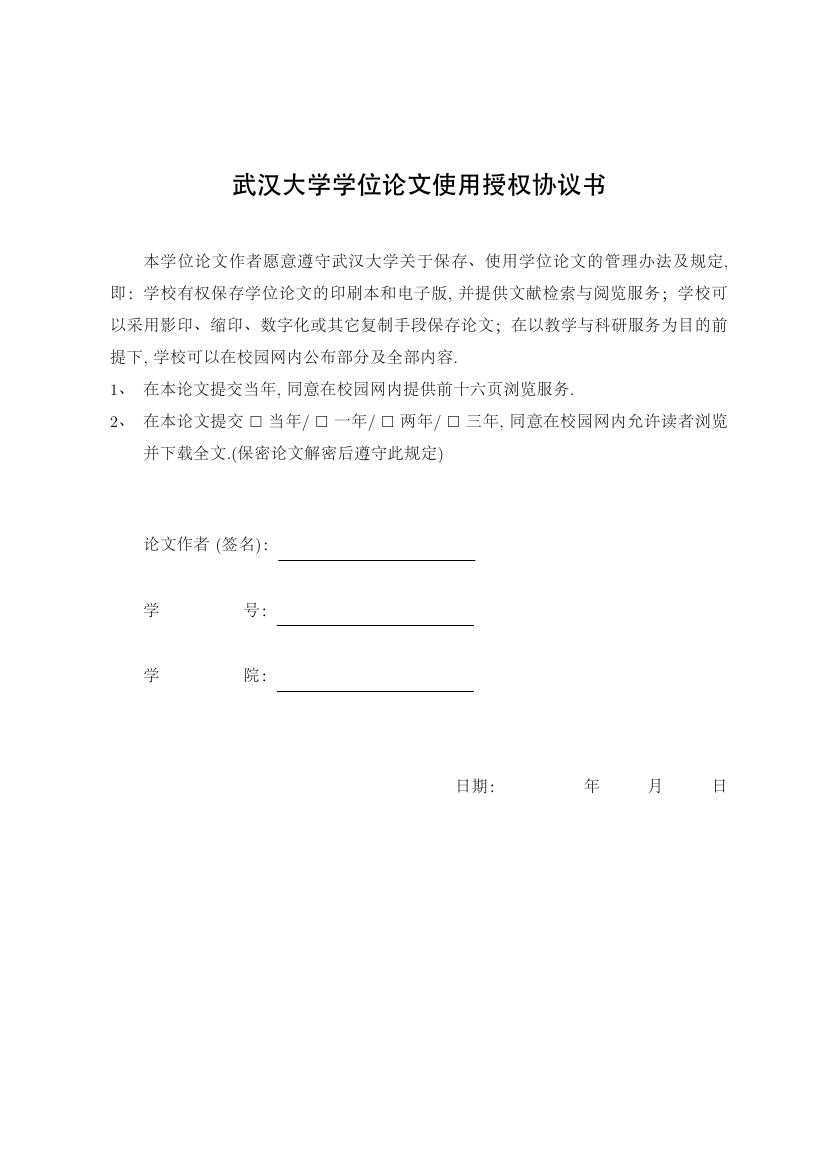



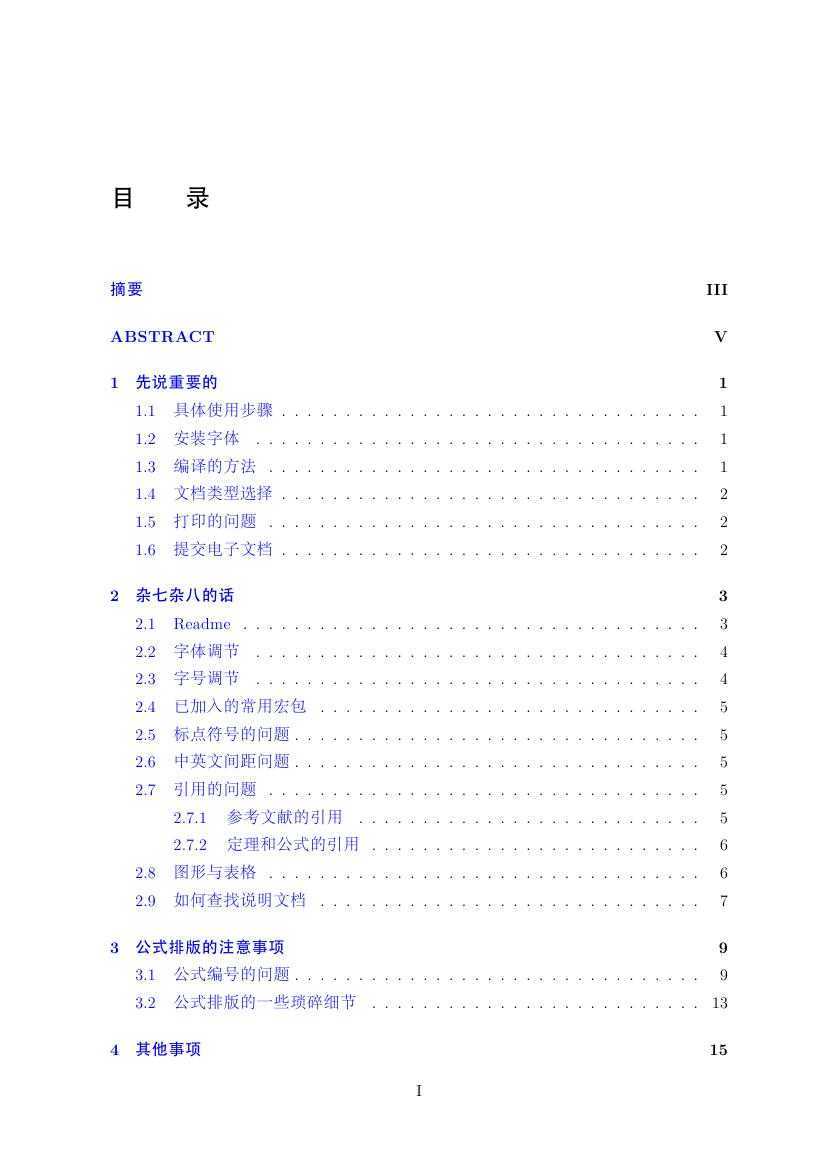
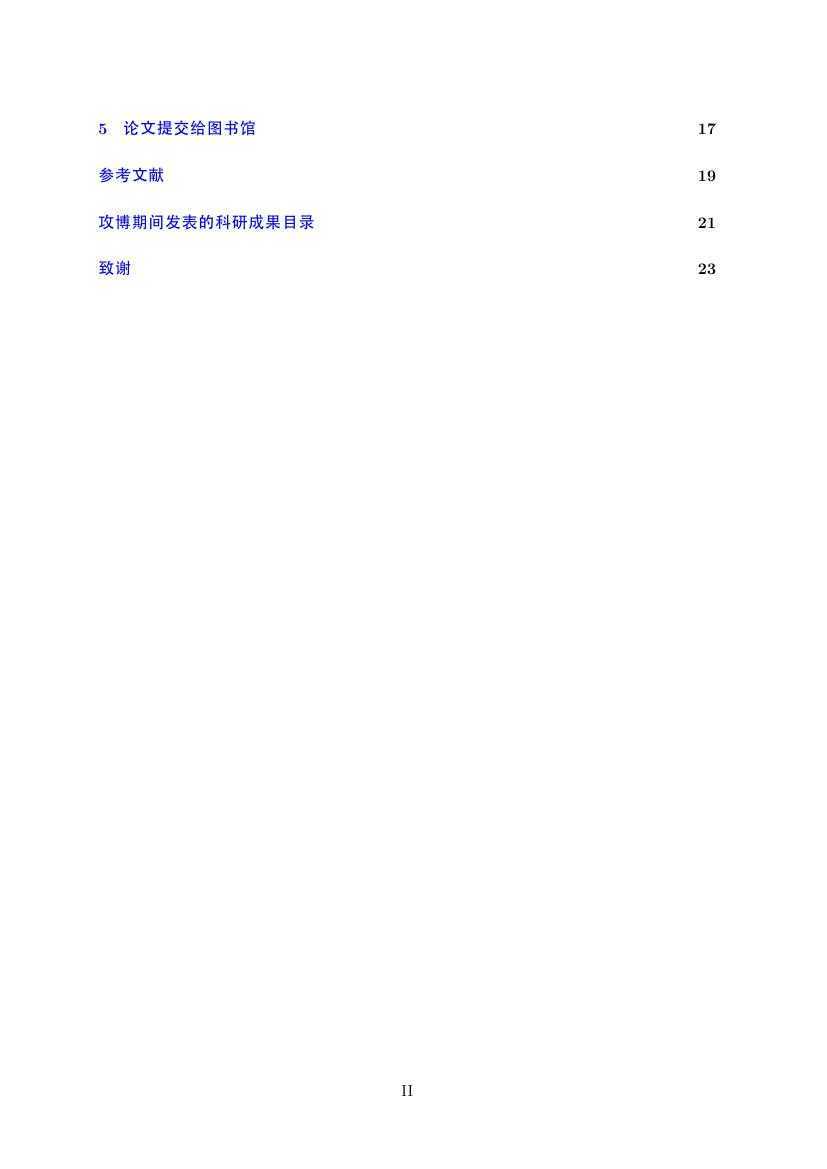
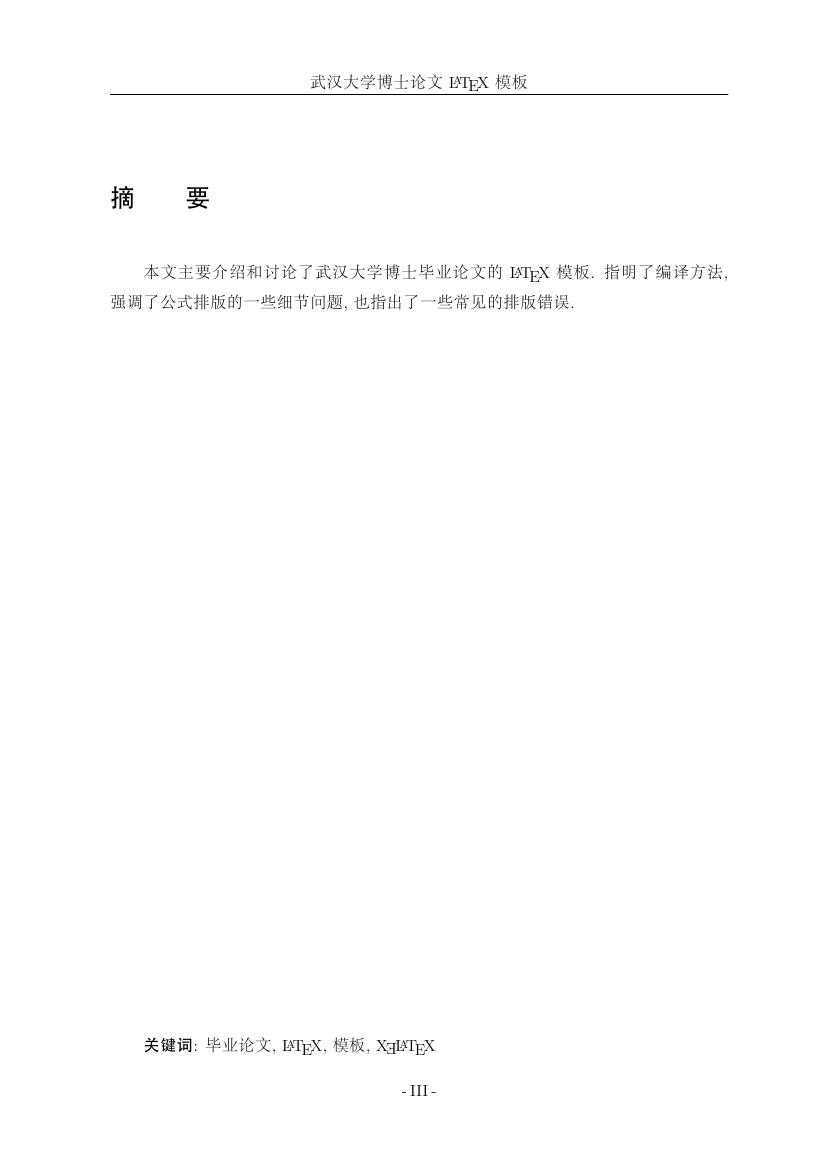

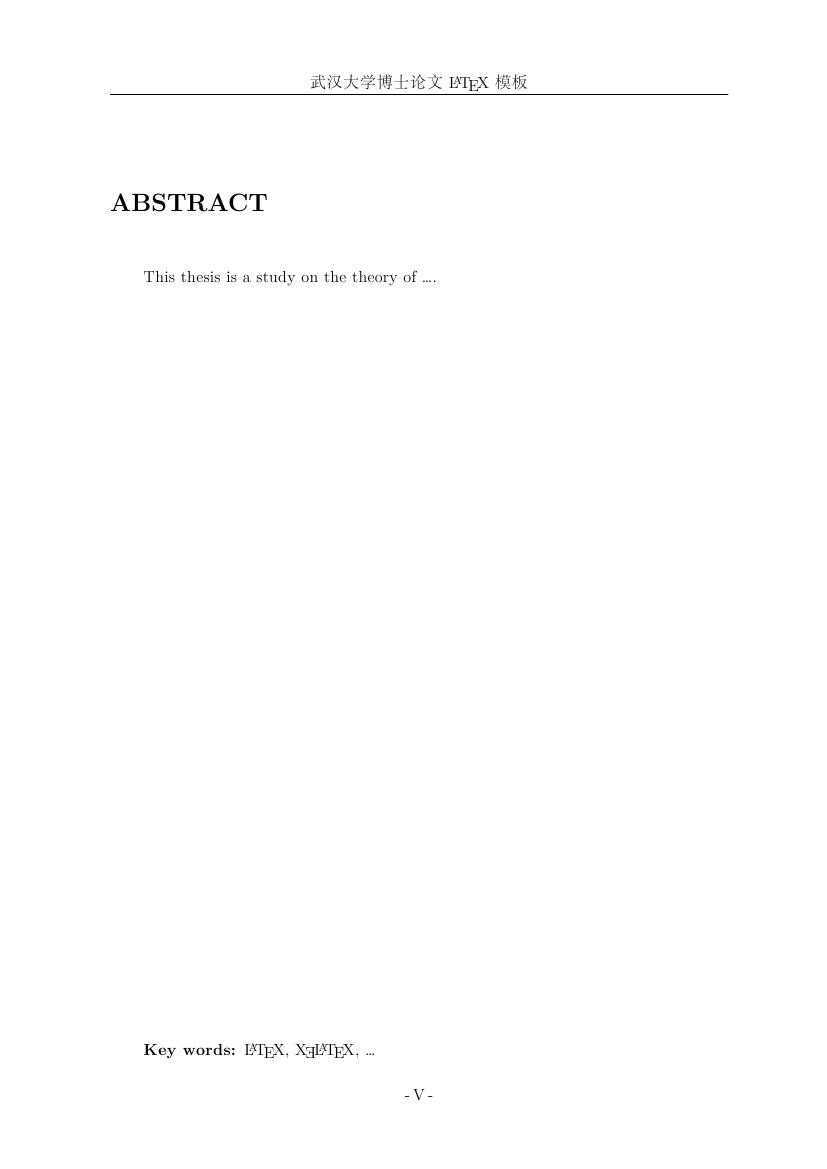



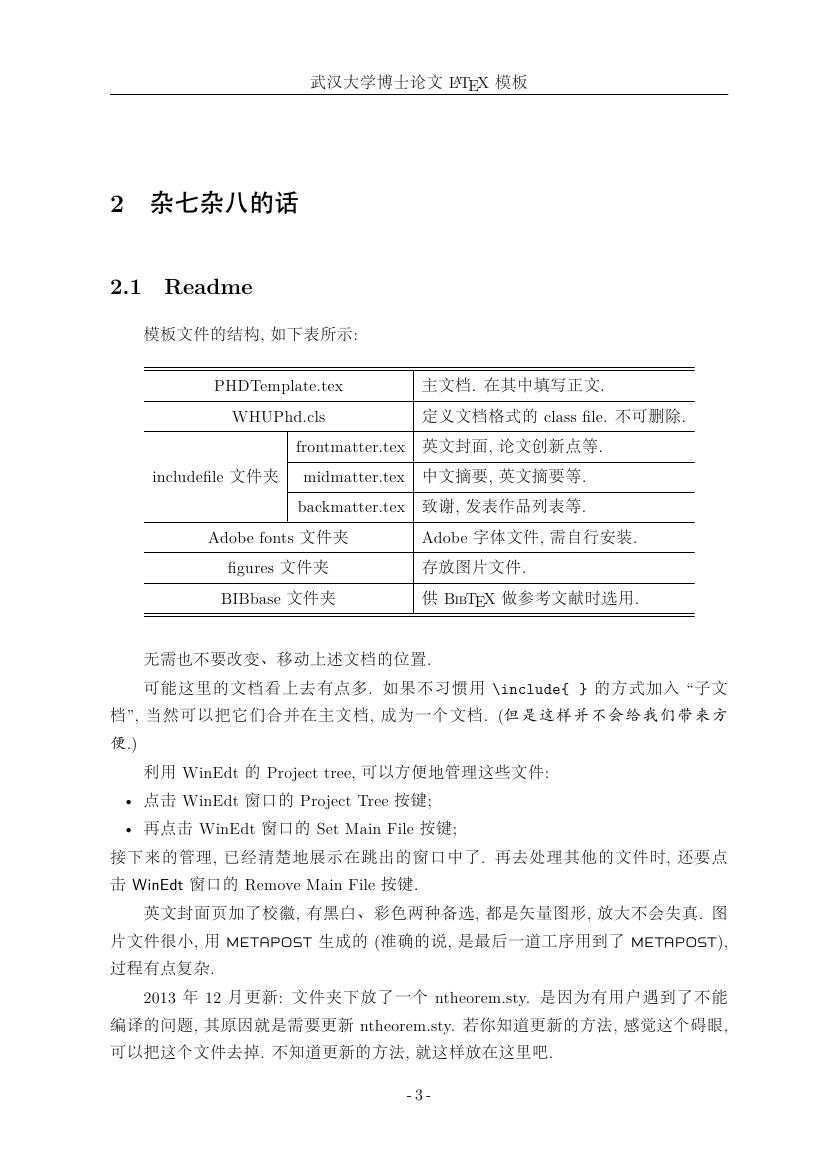
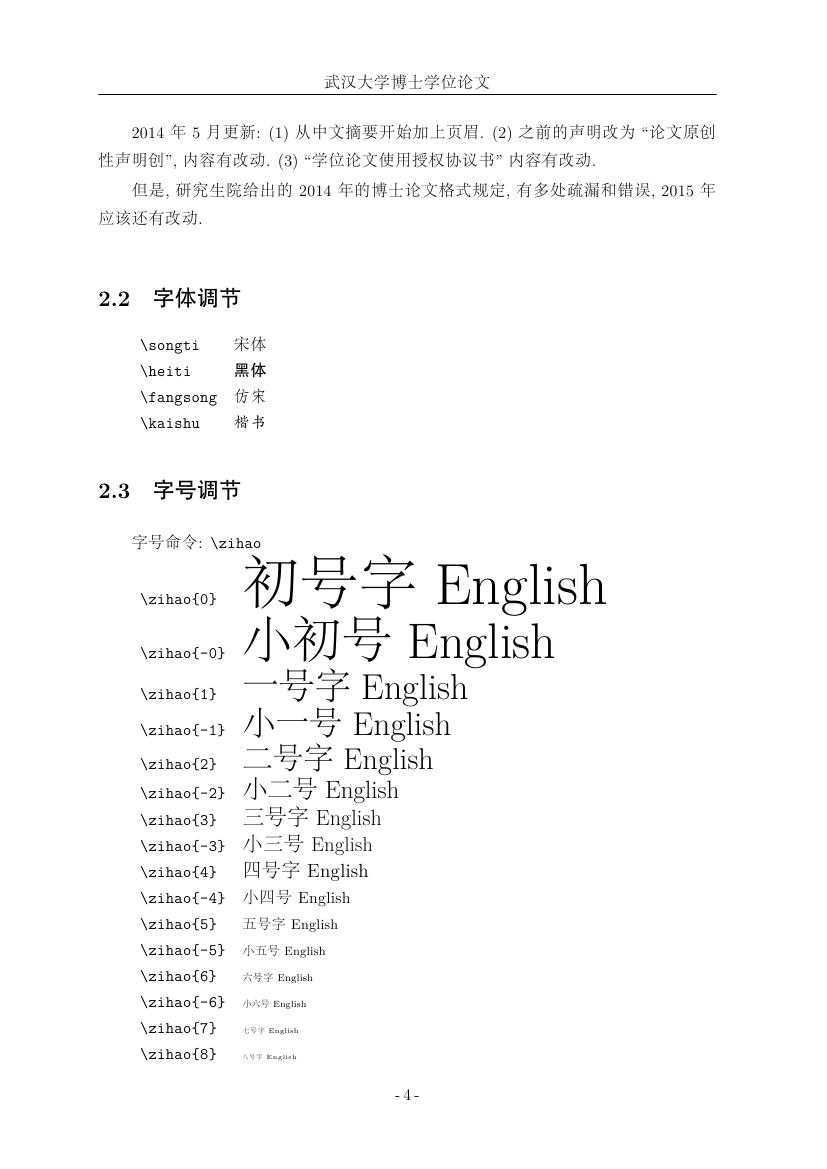
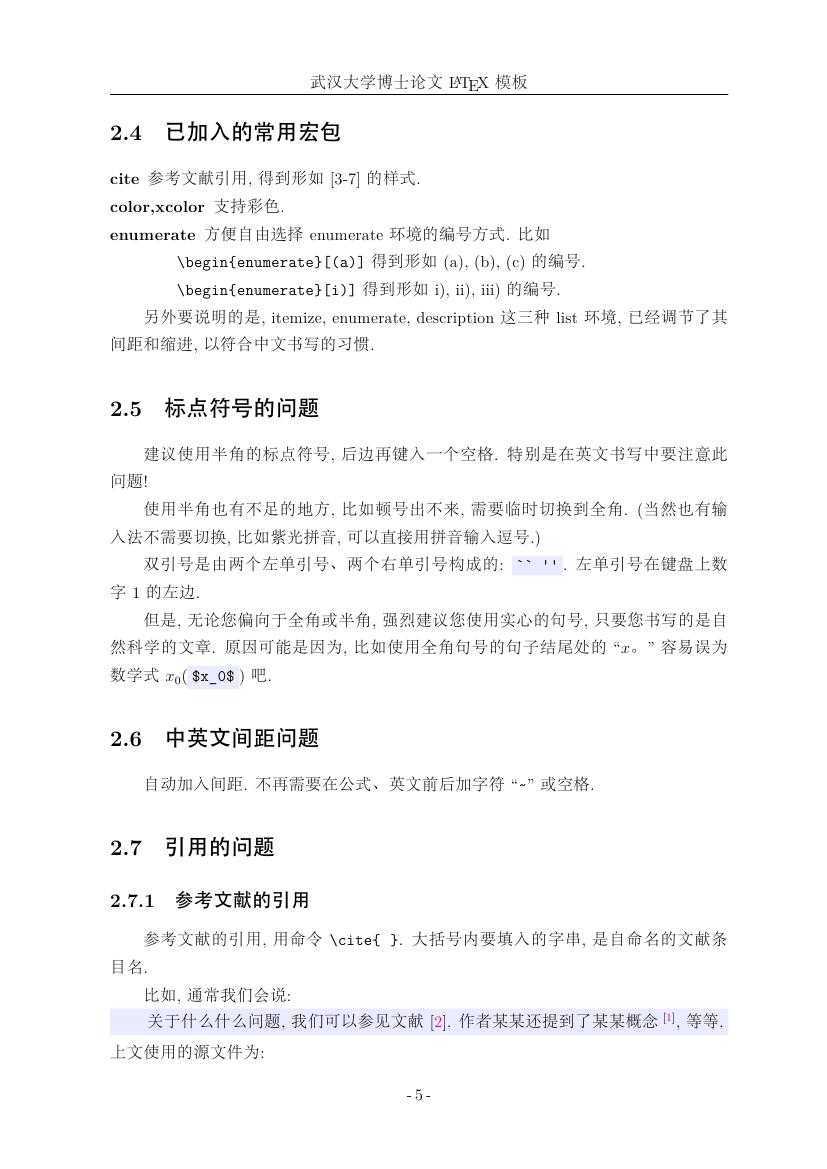
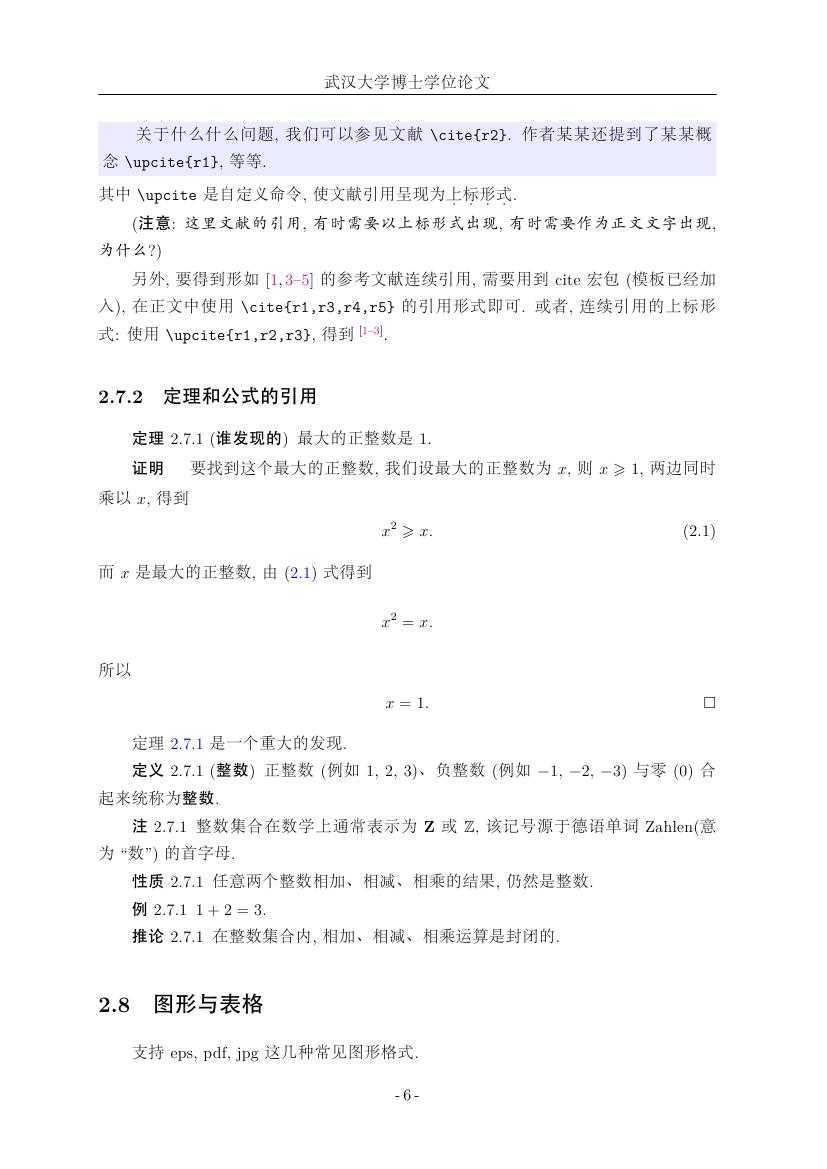
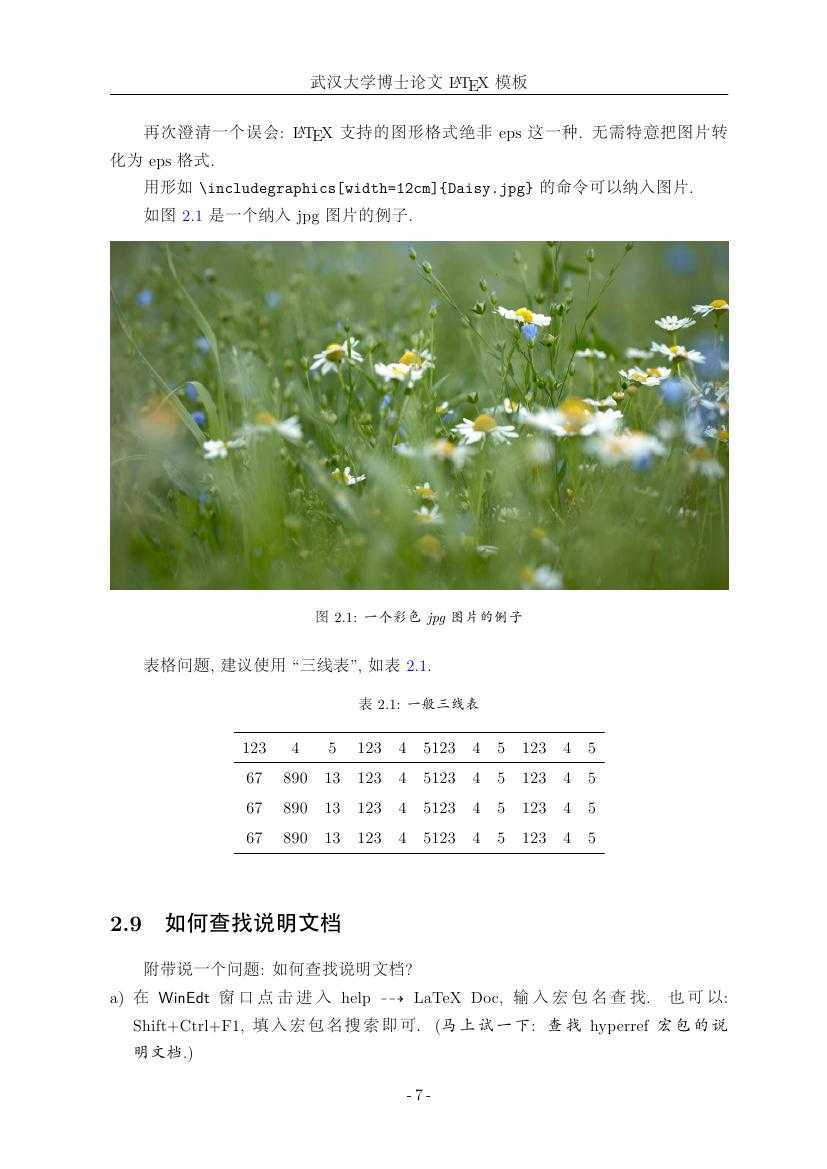
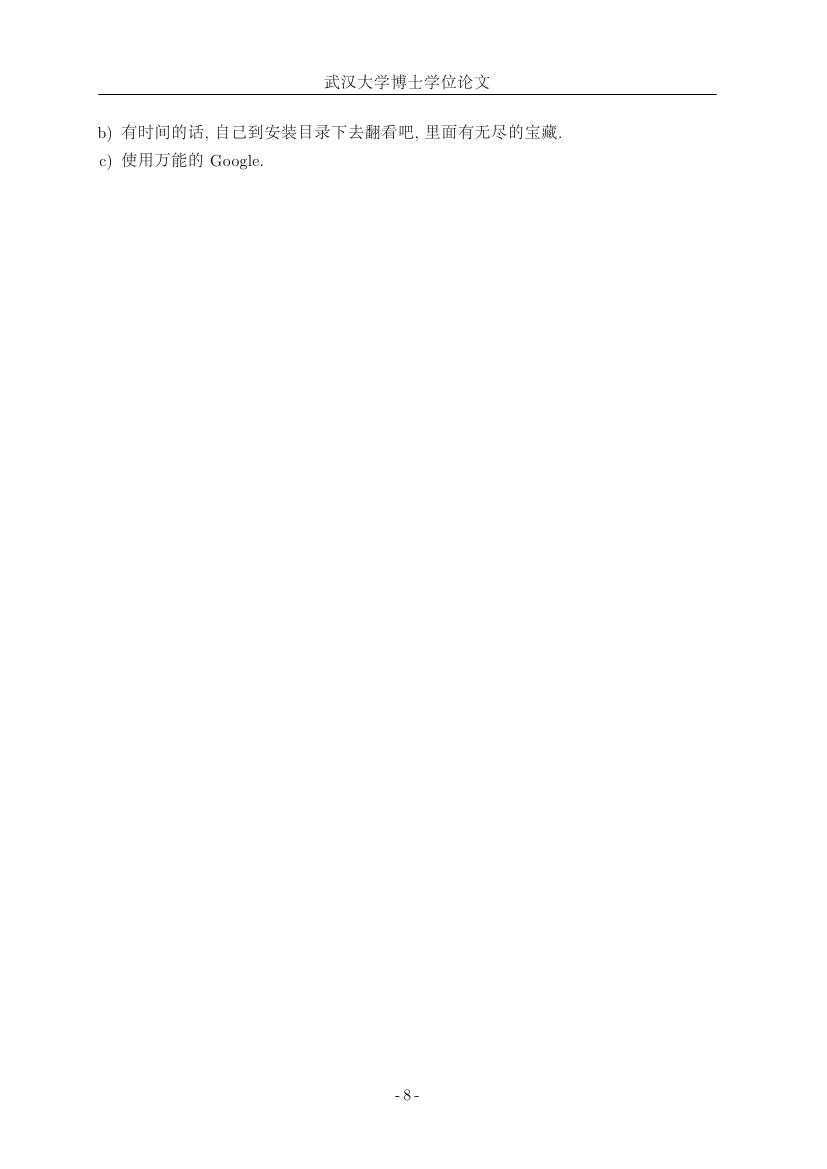
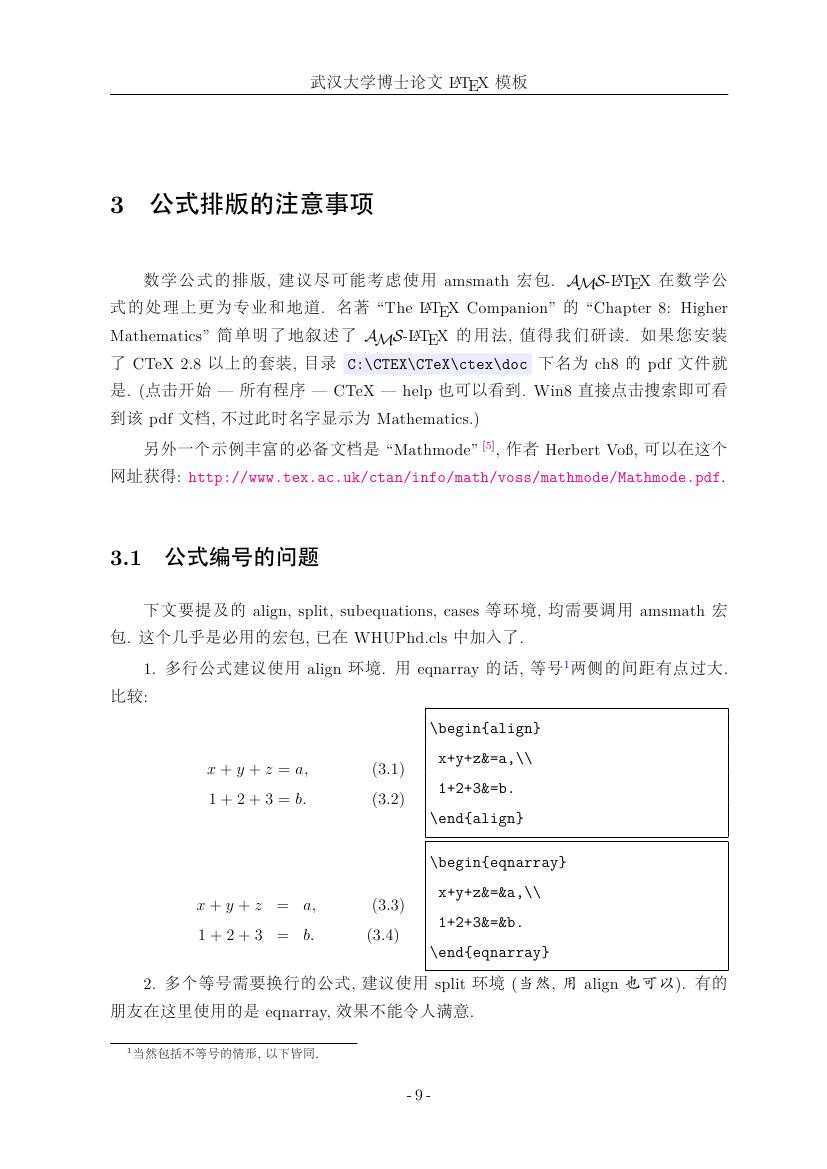
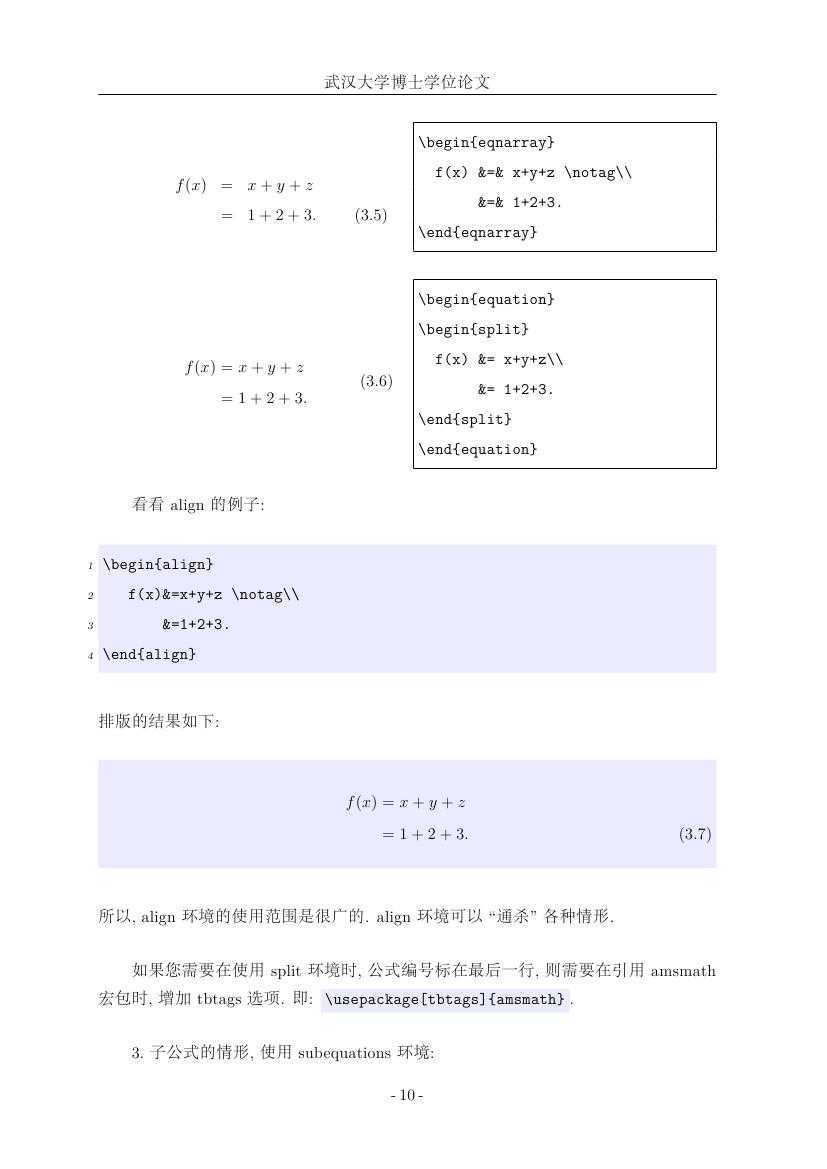
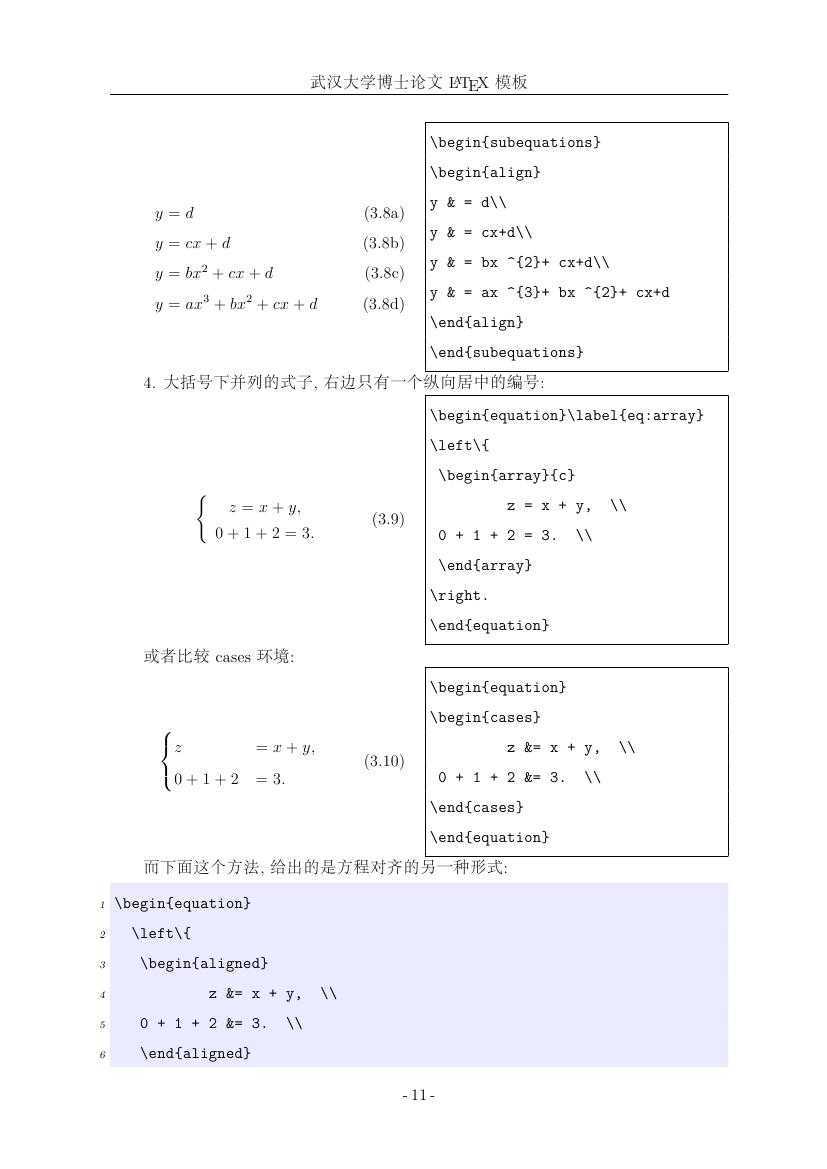
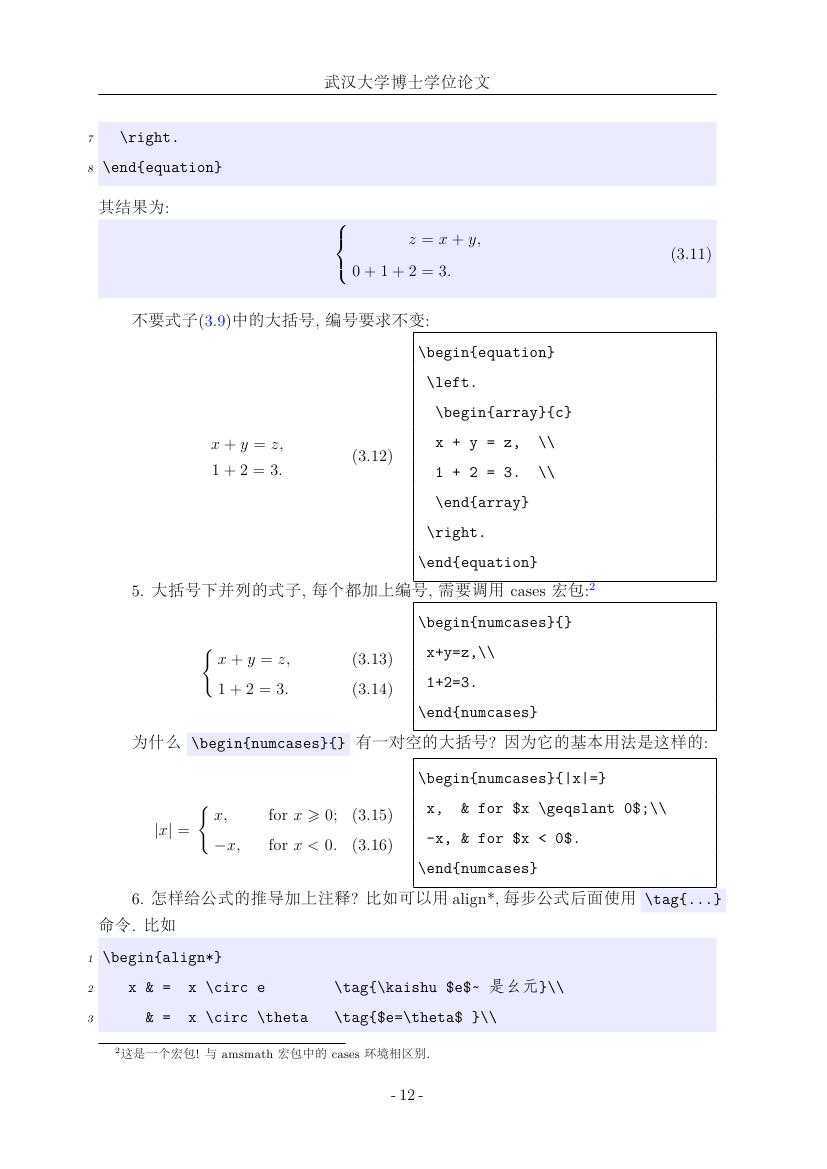
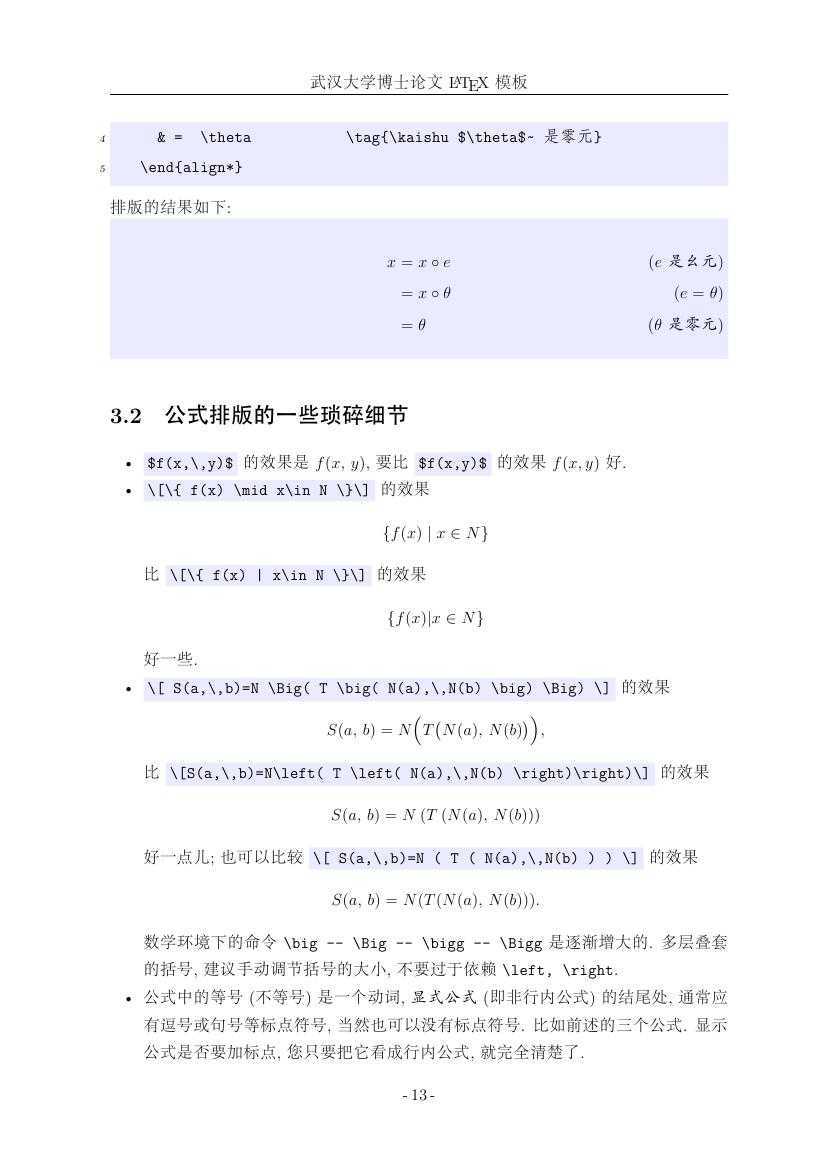
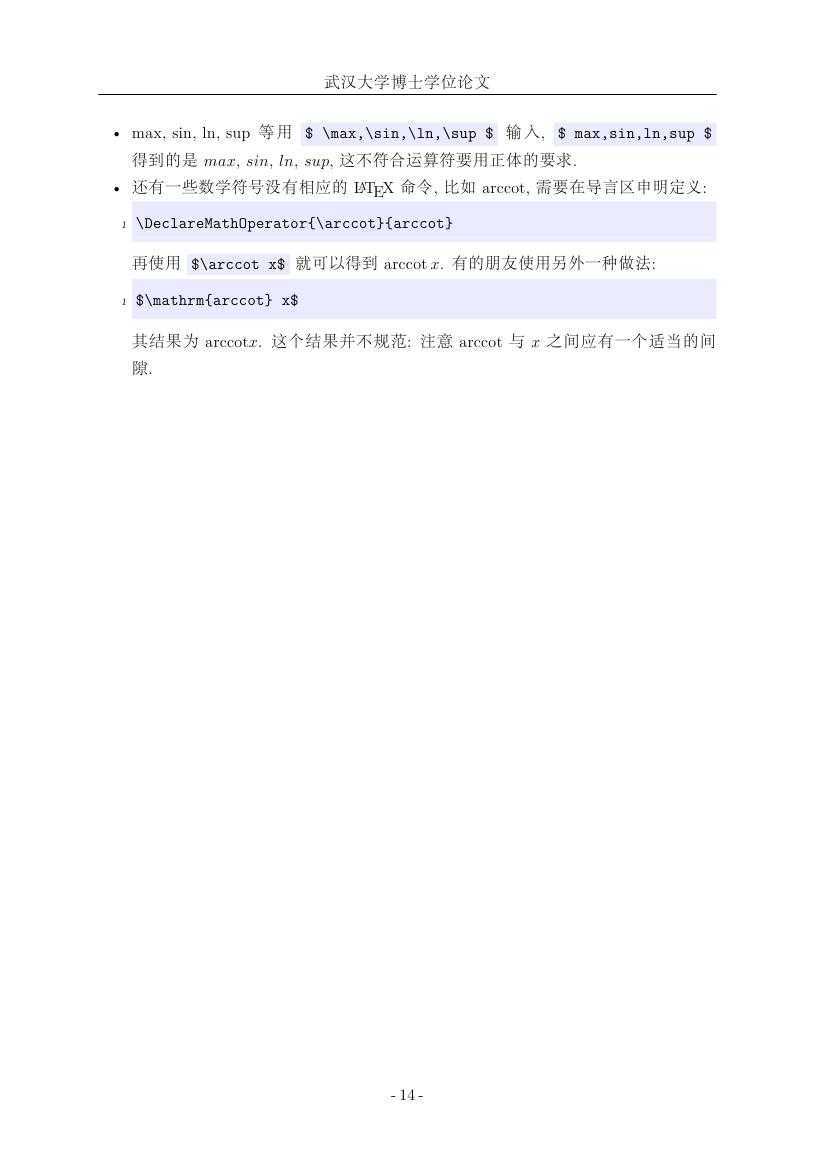
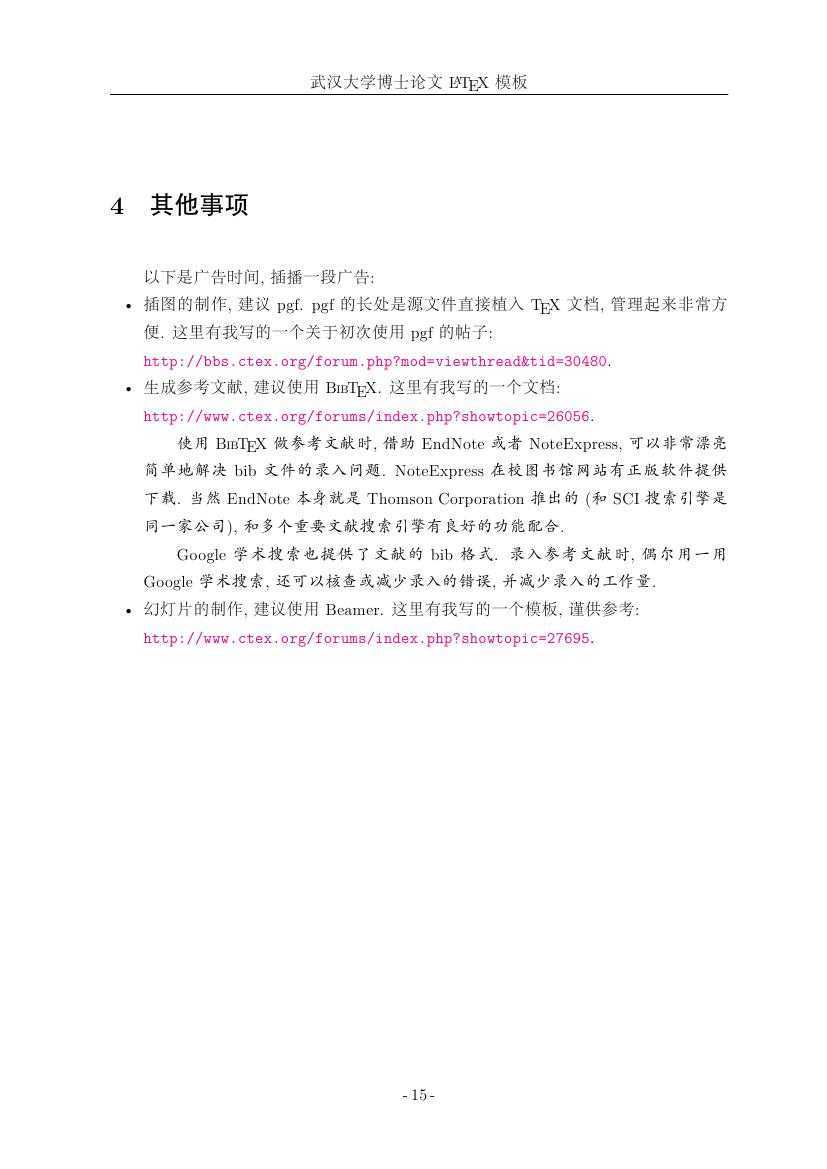

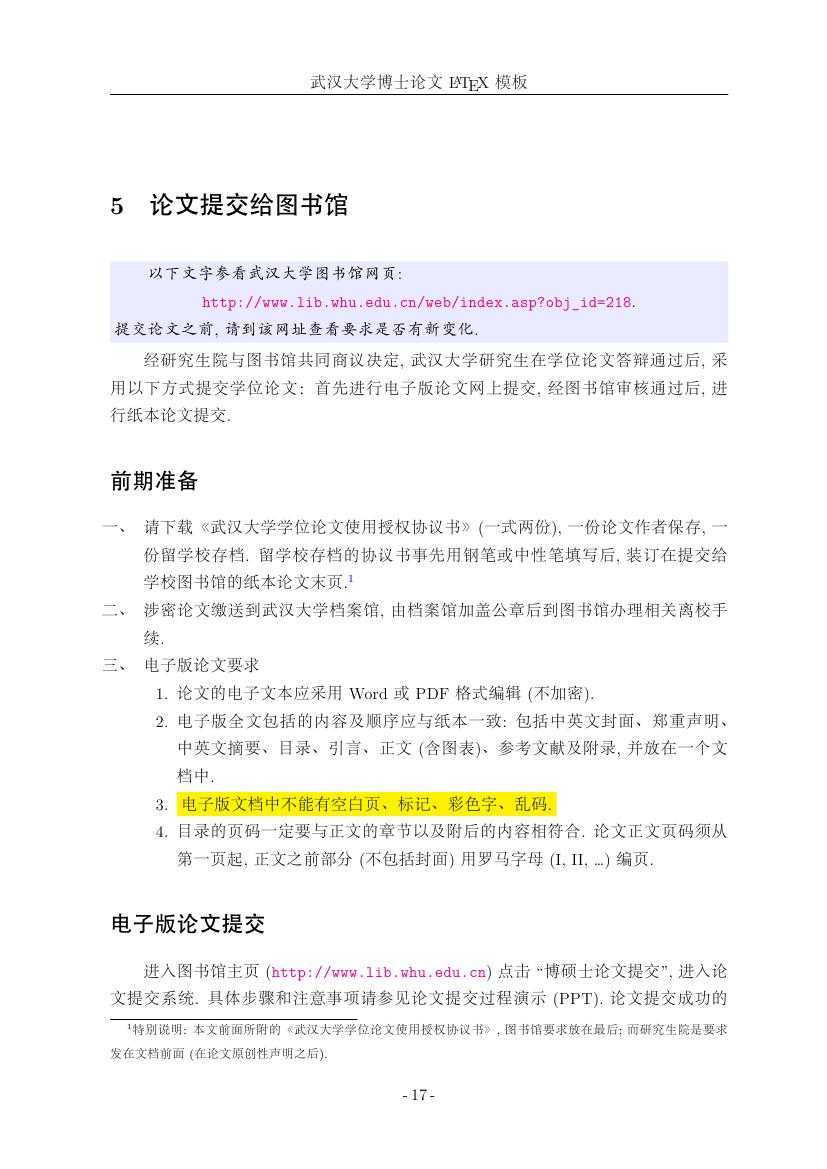
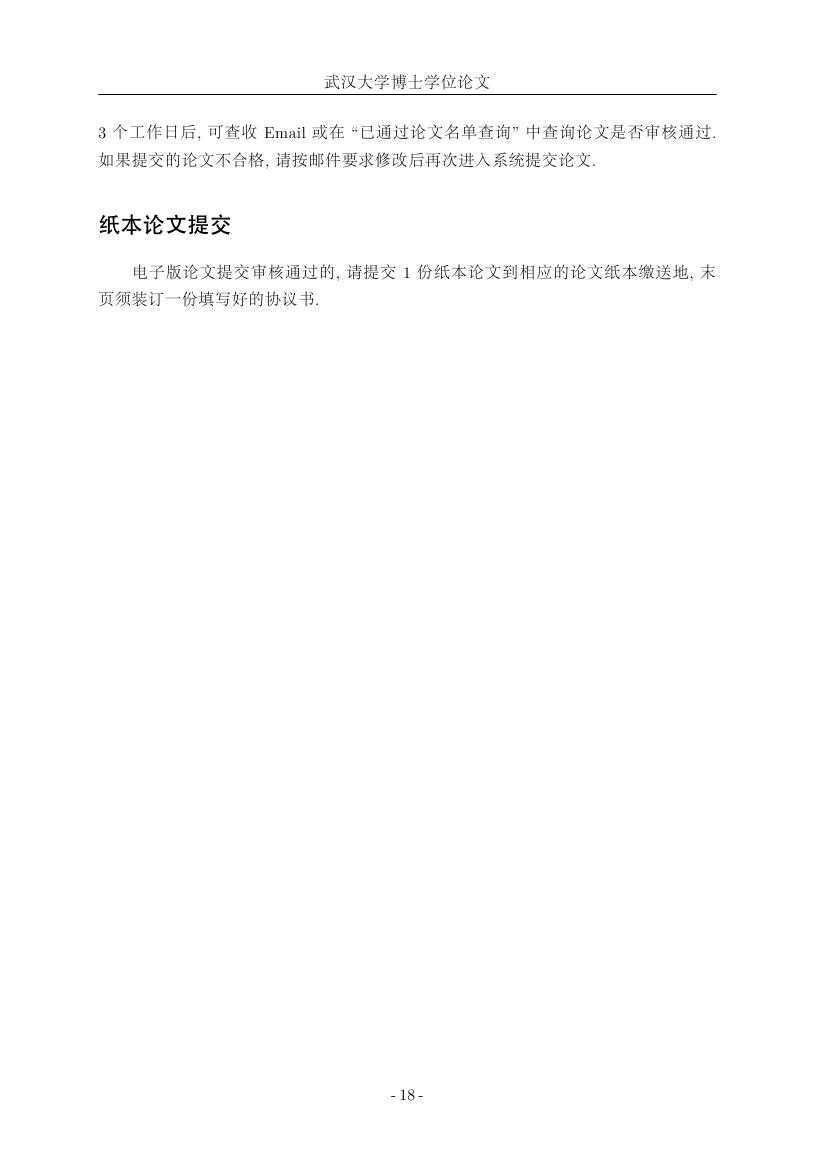
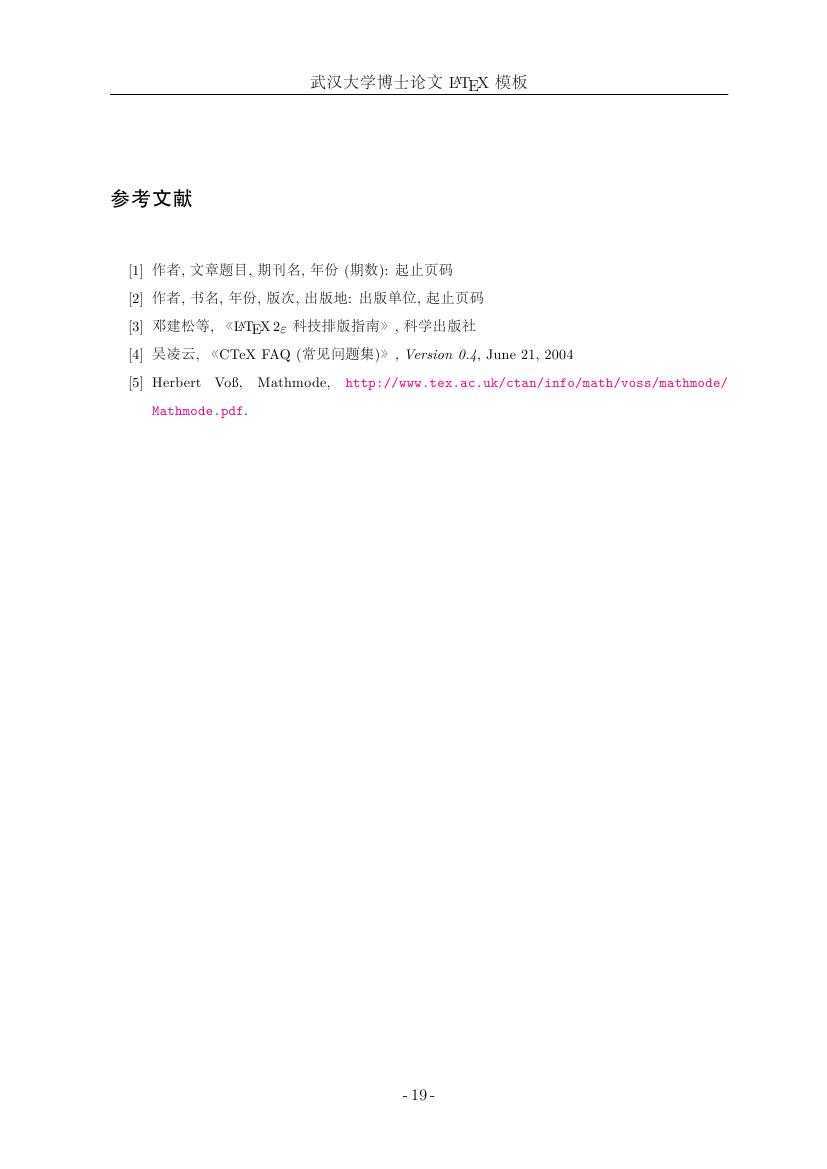



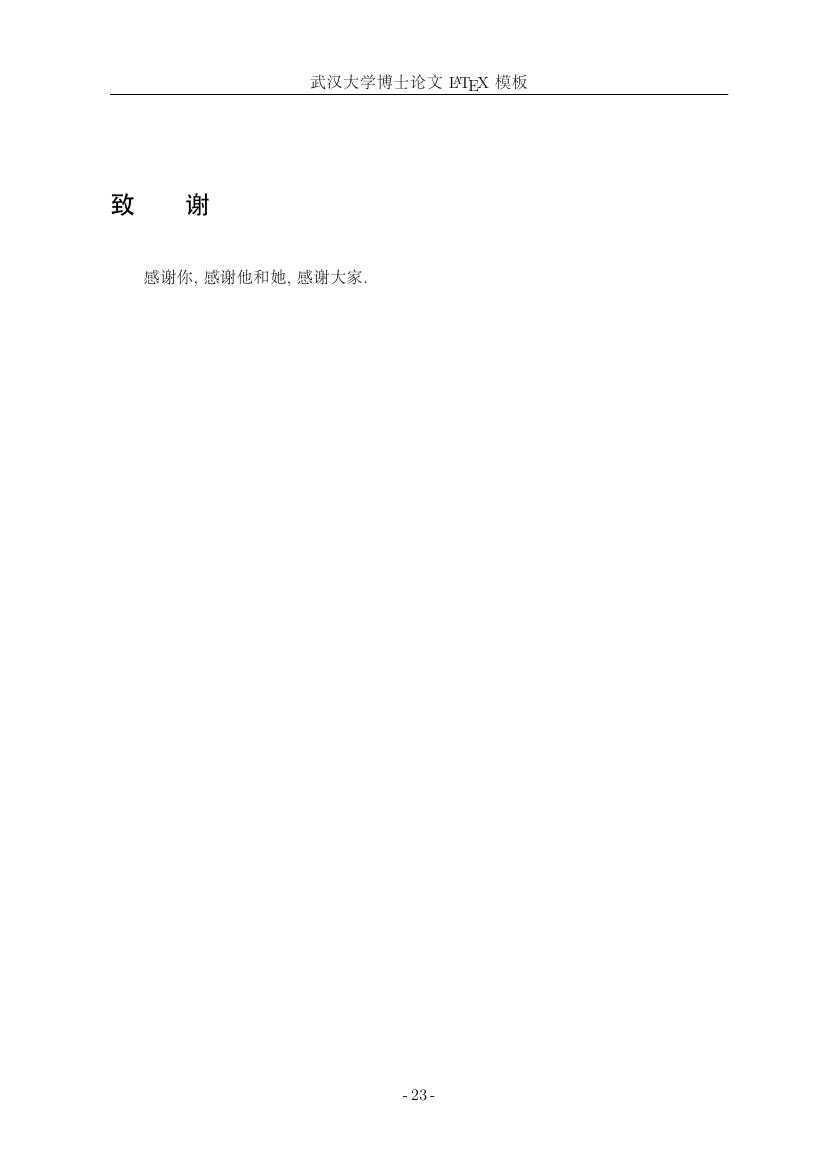

WHUPhd.cls
1 % !Mode:: "TeX:UTF-8" 2 \NeedsTeXFormat{LaTeX2e}[1999/12/01] 3 \ProvidesClass{WHUPhd}[2013/12/17 3.2 Wuhan University Thesis Template for PHD] 4 5 \newif\iflib\libfalse 6 \DeclareOption{forlib}{\libtrue} 7 \newif\ifprint\printfalse 8 \DeclareOption{forprint}{\printtrue} 9 \ProcessOptions 10 11 \iflib 12 \LoadClass[cs4size,a4paper,fancyhdr,fntef,UTF8,adobefonts,hyperref,twoside,openany]{ctexbook} 13 \else 14 \LoadClass[cs4size,a4paper,fancyhdr,fntef,UTF8,adobefonts,hyperref,twoside]{ctexbook} 15 \fi 16 17 \DeclareOption*{\PassOptionsToClass{\CurrentOption}{ctexbook}} 18 \ProcessOptions 19 %------------------------ Page layout ---------------------------------- 20 \hypersetup{pdfencoding=auto,citecolor=magenta,% magenta , cyan 21 linkcolor=blue} %%% 邓东升修改 22 \RequirePackage[top=3truecm,bottom=2.9truecm,left=2.8truecm,right=2.5truecm, 23 %includehead,%includefoot, 24 xetex]{geometry} % 页面设置% 25 26 \newtoks\fenleihao %中图分类号 27 \newtoks\bianhao %学校编号 28 \newtoks\UDC %《国际十进制分类法UDC》的类号 29 \newtoks\miji %密级 30 \newtoks\Cmajor %学科专业中文名 31 \newtoks\Emajor %学科专业英文名 32 \newtoks\Especiality %研究方向 33 \newtoks\Cspeciality %研究方向 34 \newtoks\Edate %英文日期 35 \newtoks\Etitle %英文题目 36 \newtoks\Eauthor %作者英文名 37 \newtoks\Esupervisor %指导教师英文名 38 \newtoks\Csupervisor %指导教师中文名 39 \newtoks\Schoolname %学院英文名 40 41 42 %===============================================页眉设置=====================================================% 43 \renewcommand{\headrulewidth}{0.5pt} %在页眉下画一个0.5pt宽的分隔线 44 \renewcommand{\footrulewidth}{0pt} % 在页脚不画分隔线。 45 46 \let\ps@oldplain\ps@plain 47 48 \fancyhf{} %清除以前对页眉页脚的设置 49 \fancyhead[CE]{武汉大学博士学位论文} %偶数页页眉居中位置的设置. 不填则为空. 50 \fancyhead[CO]{\@title} %L,C,R 是左中右; O,E 是奇偶. 可以自己组合调整. 51 \fancyfoot[C]{-\,\thepage\,-} %页面下侧的设置. 大括号内置空, 表示什么也不填. 反之, 没有此命令的话, 会在页脚出现页码 52 \newcommand{\fancyfancy}{\fancypagestyle{plain}{% 53 \fancyhf{} 54 \fancyhead[CE]{武汉大学博士学位论文} %偶数页页眉居中位置的设置. 不填则为空. 55 \fancyhead[CO]{\@title} %L,C,R 是左中右; O,E 是奇偶. 可以自己组合调整. 56 \fancyfoot[C]{-\,\thepage\,-} }} 57 %%%=== 封面 ===%%% 58 \def\maketitle{% 59 \null 60 \thispagestyle{empty}% 61 %\vspace*{-2cm} 62 \begin{center}\leavevmode 63 {\fangsong \zihao{4}% 64 \begin{tabular}{lp{2cm}p{5cm}lp{2cm}l} 65 \raisebox{-0.5ex}[0pt]{\makebox[1.5cm][s]{分\hfill 类\hfill 号}} & {}\hfill\raisebox{-0.5ex}[0pt]{\the\fenleihao}\hfill{} & & 66 \raisebox{-0.5ex}[0pt]{\makebox[1.5cm][s]{密\hfill 级}} & {}\hfill\raisebox{-0.5ex}[0pt]{\the\miji}\hfill{} & \\ \cline{2-2}\cline{5-5} 67 \raisebox{-0.5ex}[0pt]{\makebox[1.5cm][s]{U\hfill D\hfill C} } & {}\hfill\raisebox{-0.5ex}[0pt]{\the\UDC}\hfill{} & & 68 \raisebox{-0.5ex}[0pt]{\makebox[1.5cm][s]{编\hfill 号}} & {}\hfill\raisebox{-0.5ex}[0pt]{\the\bianhao}\hfill{} & \\ \cline{2-2}\cline{5-5} 69 \end{tabular} 70 } 71 \par 72 \vspace*{15mm} %插入空白 73 {\songti \zihao{2} \ziju{0.5} 武汉大学 \\[3mm] 博士学位论文}\ 74 \vspace{2cm} 75 {\kaishu \zihao{1} \@title \par}% 76 % \vspace{4cm} 77 \vfill\vfill\vfill 78 {\songti\zihao{4} 79 \begin{tabular}{cp{5.5cm}c} 80 \raisebox{-3ex}[0pt]{\makebox[4.8cm][s]{研\hfill 究\hfill 生\hfill 姓\hfill 名: }} & {\songti {}\raisebox{-3ex}[0pt]{\@author}\hfill{}} & \\[3ex] 81 \raisebox{-3ex}[0pt]{\makebox[4.8cm][s]{指\hfill 导\hfill 教\hfill 师\hfill 姓\hfill 名、\hfill 职\hfill 称: }} & {\songti 82 {}\raisebox{-3ex}[0pt]{\the\Csupervisor}\hfill{}} & \\[3ex] % \cline{2-2} 83 \raisebox{-3ex}[0pt]{\makebox[4.8cm][s]{专\hfill 业\hfill 名\hfill 称: }} & {\songti {}\raisebox{-3ex}[0pt]{\the\Cmajor}\hfill{}} & 84 \\[3ex] 85 \raisebox{-3ex}[0pt]{\makebox[4.8cm][s]{研\hfill 究\hfill 方\hfill 向: }} & {\songti{}\raisebox{-3ex}[0pt]{\the\Cspeciality}\hfill{}} & \\[3ex] 86 \end{tabular} 87 } 88 \par 89 \vspace{25mm} 90 { 91 % {\heiti \zihao{3} \the\year~年 ~\the\month~月 ~\the\day~日 \par}% 92 {\heiti \zihao{3} \@date \par}% 93 } 94 %\vspace*{-0.7cm} 95 \end{center}% 96 \null 97 \iflib 98 \else 99 \newpage 100 \thispagestyle{empty} 101 \cleardoublepage 102 \fi 103 } 104 105 %------------------------ Abstract & Keywords ------------------------- 106 \newcommand\cnabstractname{摘要} 107 \newcommand\enabstractname{ABSTRACT} 108 \newcommand\cnkeywords[1]{ {\heiti\zihao{-4}\cnkeywordsname: }#1} 109 \newcommand\cnkeywordsname{关键词} 110 \newcommand\enkeywords[1]{ {\bfseries\zihao{-4}\enkeywordsname: }#1} 111 \newcommand\enkeywordsname{Key words} 112 113 \newenvironment{cnabstract}{ 114 \newpage 115 \chapter[\cnabstractname]{\ziju{2}{\cnabstractname}} %%%终于解决了书签乱码的问题 2005-04-12.huangzh 116 \songti\zihao{-4} 117 \@afterheading} 118 {\par} 119 120 \newenvironment{enabstract}{ 121 \newpage 122 \chapter{\enabstractname} 123 \songti\zihao{-4} 124 \@afterheading} 125 {\par} 126 %%------------------------常用宏包----------------------------------- 127 \RequirePackage{amsmath,amssymb}% AMSLaTeX宏包. 128 \RequirePackage[amsmath,thmmarks]{ntheorem} 129 \RequirePackage{graphicx} % 图形 130 \RequirePackage{color,xcolor} %支持彩色 131 \RequirePackage{cite} % 参考文献引用, 得到形如 [3-7] 的样式. 132 \RequirePackage{url} 133 \RequirePackage{enumerate} 134 %%----------------------- Theorems ----------------------------------- 135 \theoremstyle{plain} 136 \theoremheaderfont{\heiti} 137 \theorembodyfont{\songti} \theoremindent0em 138 \theorempreskip{0pt} 139 \theorempostskip{0pt} 140 %\theoremseparator{\hspace{1em}} 141 \theoremnumbering{arabic} 142 %\theoremsymbol{} %定理结束时自动添加的标志 143 \newtheorem{theorem}{\hspace{2em}定理}[section] 144 \newtheorem{definition}{\hspace{2em}定义}[section] 145 \newtheorem{lemma}{\hspace{2em}引理}[section] 146 \newtheorem{corollary}{\hspace{2em}推论}[section] 147 \newtheorem{proposition}{\hspace{2em}性质}[section] 148 \newtheorem{example}{\hspace{2em}例}[section] 149 \newtheorem{remark}{\hspace{2em}注}[section] 150 151 \theoremstyle{nonumberplain} 152 \theoremheaderfont{\heiti} 153 \theorembodyfont{\normalfont \rm \songti} 154 \theoremindent0em \theoremseparator{\hspace{1em}} 155 \theoremsymbol{$\square$} 156 \newtheorem{proof}{\hspace{2em}证明} 157 158 %%%--- Publications ------------------------------- 159 \newenvironment{publications}[1] 160 {\renewcommand\bibname{}\begin{thebibliography}{#1}} 161 {\end{thebibliography}} 162 163 %%%--- \upcite ---------------------------------------- 164 \newcommand{\upcite}[1]{\textsuperscript{\cite{#1}}} %自定义新命令\upcite, 使参考文献引用以上标出现 165 166 %%%%%%%--判断是否需要彩色链接----------------------------- 167 \iflib 168 \hypersetup{allcolors=black} 169 \else 170 \fi 171 %%%%%%%------------------------------------------------- 172 %%%%%%%--判断是否需要彩色链接----------------------------- 173 \ifprint 174 \hypersetup{allcolors=black} 175 \else 176 \fi 177 %%%%%%%------------------------------------------------- 178 %%%=== suppress extra inter-line spacing in \list environments 179 \makeatletter \setlength\partopsep{0pt} 180 \def\@listI{\leftmargin\leftmargini 181 \parsep 0pt 182 \topsep \parsep 183 \itemsep \parsep} 184 \@listI 185 \def\@listii {\leftmargin\leftmarginii 186 \labelwidth\leftmarginii 187 \advance\labelwidth-\labelsep 188 \parsep \z@ \@plus\z@ \@minus\z@ 189 \topsep \parsep 190 \itemsep \parsep} 191 \def\@listiii{\leftmargin\leftmarginiii 192 \labelwidth\leftmarginiii 193 \advance\labelwidth-\labelsep 194 \parsep \z@ \@plus\z@ \@minus\z@ 195 \topsep \parsep 196 \itemsep \parsep} 197 \def\@listiv{\leftmargin\leftmarginiv 198 \labelwidth\leftmarginiv 199 \advance\labelwidth-\labelsep 200 \parsep \z@ \@plus\z@ \@minus\z@ 201 \topsep \parsep 202 \itemsep \parsep} 203 \def\@listv{\leftmargin\leftmarginv 204 \labelwidth\leftmarginv 205 \advance\labelwidth-\labelsep 206 \parsep \z@ \@plus\z@ \@minus\z@ 207 \topsep \parsep 208 \itemsep \parsep} 209 \def\@listvi{\leftmargin\leftmarginvi 210 \labelwidth\leftmarginvi 211 \advance\labelwidth-\labelsep 212 \parsep \z@ \@plus\z@ \@minus\z@ 213 \topsep \parsep 214 \itemsep \parsep} 215 % 216 % Change default margins for \list environments 217 \setlength\leftmargini {2\ccwd} \setlength\leftmarginii 218 {\leftmargini} \setlength\leftmarginiii {\leftmargini} 219 \setlength\leftmarginiv {\leftmargini} \setlength\leftmarginv 220 {\ccwd} \setlength\leftmarginvi {\ccwd} \setlength\leftmargin 221 {\leftmargini} \setlength\labelsep {.5\ccwd} 222 \setlength\labelwidth {\leftmargini} 223 % 224 \setlength\listparindent{2\ccwd} 225 % Change \listparindent to 2\ccwd in \list 226 \def\list#1#2{\ifnum \@listdepth >5\relax \@toodeep 227 \else \global\advance\@listdepth\@ne \fi 228 \rightmargin \z@ \listparindent2\ccwd \itemindent \z@ 229 \csname @list\romannumeral\the\@listdepth\endcsname 230 \def\@itemlabel{#1}\let\makelabel\@mklab \@nmbrlistfalse #2\relax 231 \@trivlist 232 \parskip\parsep \parindent\listparindent 233 \advance\linewidth -\rightmargin \advance\linewidth -\leftmargin 234 \advance\@totalleftmargin \leftmargin 235 \parshape \@ne \@totalleftmargin \linewidth 236 \ignorespaces} 237 238 \makeatother 239 %--------------------------------------------------- 240 \renewcommand{\contentsname}{目\qquad 录} 241 \newcommand\acknowledgement{\backmatter\chapter[致谢]{\ziju{2}致谢}} 242 \newcommand\reseachresult{\backmatter\chapter{攻博期间发表的科研成果目录}} 243 244 %%% ---- 章节标题设置 ----- %%%% 245 \CTEXsetup[nameformat={\zihao{-2}\bfseries\raggedright},titleformat={\zihao{-2}\bfseries\raggedright},% 246 number={\arabic{chapter}},name={,},afterskip={30pt},beforeskip={20pt}]{chapter} 247 \CTEXsetup[format+={\zihao{3}\raggedright}]{section} 248 \CTEXsetup[format+={\zihao{4}\raggedright}]{subsection} 249 \CTEXsetup[format={\zihao{-4}\kaishu\raggedright}]{subsubsection} 250 \CTEXoptions[bibname={\large 参考文献}] 251 \setcounter{tocdepth}{4} 252 \setcounter{secnumdepth}{4} 253 \RequirePackage[font=small,textfont=it]{caption} 254 255 \allowdisplaybreaks 256 \endlinechar `\^^M 257 \endinput
ntheorem.sty
1 %% 2 %% This is file `ntheorem.sty‘, 3 %% generated with the docstrip utility. 4 %% 5 %% The original source files were: 6 %% 7 %% ntheorem.dtx (with options: `package‘) 8 %% 9 %% IMPORTANT NOTICE: 10 %% 11 %% For the copyright see the source file. 12 %% 13 %% Any modified versions of this file must be renamed 14 %% with new filenames distinct from ntheorem.sty. 15 %% 16 %% For distribution of the original source see the terms 17 %% for copying and modification in the file ntheorem.dtx. 18 %% 19 %% This generated file may be distributed as long as the 20 %% original source files, as listed above, are part of the 21 %% same distribution. (The sources need not necessarily be 22 %% in the same archive or directory.) 23 \def\filedate{2011/08/15} 24 \def\docdate{2011/08/15} 25 \def\fileversion{1.33} 26 \def\basename{ntheorem} 27 %% This file may be distributed and/or modified under the 28 %% conditions of the LaTeX Project Public License, either version 1.2 29 %% of this license or (at your option) any later version. 30 %% The latest version of this license is in 31 %% http://www.latex-project.org/lppl.txt 32 %% and version 1.2 or later is part of all distributions of LaTeX 33 %% version 1999/12/01 or later. 34 %% \CharacterTable 35 %% {Upper-case \A\B\C\D\E\F\G\H\I\J\K\L\M\N\O\P\Q\R\S\T\U\V\W\X\Y\Z 36 %% Lower-case \a\b\c\d\e\f\g\h\i\j\k\l\m\n\o\p\q\r\s\t\u\v\w\x\y\z 37 %% Digits \0\1\2\3\4\5\6\7\8\9 38 %% Exclamation \! Double quote \" Hash (number) \# 39 %% Dollar \$ Percent \% Ampersand \& 40 %% Acute accent \‘ Left paren \( Right paren \) 41 %% Asterisk \* Plus \+ Comma \, 42 %% Minus \- Point \. Solidus \/ 43 %% Colon \: Semicolon \; Less than \< 44 %% Equals \= Greater than \> Question mark \? 45 %% Commercial at \@ Left bracket \[ Backslash \ 46 %% Right bracket \] Circumflex \^ Underscore \_ 47 %% Grave accent \` Left brace \{ Vertical bar \| 48 %% Right brace \} Tilde \~} 49 50 \typeout{Style `\basename‘, Version \fileversion\space <\filedate>} 51 \ProvidesPackage{ntheorem}[\filedate \space\fileversion] 52 \RequirePackage{ifthen}% 53 \newif\if@thmmarks\@thmmarksfalse 54 \newif\if@thref\@threffalse 55 \newif\ifthm@inframe\thm@inframefalse 56 \newif\ifthm@tempif 57 \DeclareOption{thmmarks}{%********************************* 58 \PackageInfo{\basename}{Option `thmmarks‘ loaded}% 59 \@thmmarkstrue 60 \newcounter{endNonectr} 61 \newcounter{currNonectr} 62 \newif\ifsetendmark\setendmarktrue 63 \gdef\thm@romannum#1{\expandafter\thm@roman@num\csname c@#1\endcsname}% 64 \gdef\thm@roman@num#1{\romannumeral #1}% 65 \gdef\endtrivlist{% 66 \@endtrivlist{\PotEndMark{\unskip\nobreak\hfill\nobreak}}} 67 \gdef\@endtrivlist#1{% % from \endtrivlist 68 \if@inlabel \indent\fi 69 \if@newlist \@noitemerr\fi 70 \ifhmode 71 \ifdim\lastskip >\z@ #1\unskip \par %<<<<<<<<<<<<<<<<<<<<<< 72 \else \unskip \par \fi 73 \fi 74 \if@noparlist \else 75 \ifdim\lastskip >\z@ 76 \@tempskipa\lastskip \vskip -\lastskip 77 \advance\@tempskipa\parskip \advance\@tempskipa -\@outerparskip 78 \vskip\@tempskipa 79 \fi 80 \@endparenv 81 \fi} 82 \gdef\SetMark@endeqn{\quad}% as default, cf. option leqno 83 \gdef\endequation{\eqno \hbox{\@eqnnum \PotEndMark{\SetMark@endeqn}}% 84 $$\global\@ignoretrue} 85 \gdef\[{% 86 \relax\ifmmode 87 \@badmath 88 \else 89 \ifvmode 90 \nointerlineskip 91 \makebox[.6\linewidth]% 92 \fi 93 $$\stepcounter{end\InTheoType ctr}% 94 \@ifundefined{mark\thm@romannum{curr\InTheoType ctr}% 95 \InTheoType\thm@romannum{end\InTheoType ctr}}{\relax}% 96 {\ifx\csname\InTheoType Symbol\endcsname\@empty\else 97 \boxmaxdepth=.5ex\begin{array}[b]{@{}l}% 98 \boxmaxdepth=\maxdimen\displaystyle\fi}% 99 \addtocounter{end\InTheoType ctr}{-1}% 100 %%$$ BRACE MATCH HACK 101 \fi} 102 \gdef\]{% 103 \stepcounter{end\InTheoType ctr}% 104 \@ifundefined{mark\thm@romannum{curr\InTheoType ctr}% 105 \InTheoType\thm@romannum{end\InTheoType ctr}}{\relax}% 106 {\ifx\csname\InTheoType Symbol\endcsname\@empty\else 107 \end{array}\fi}% 108 \addtocounter{end\InTheoType ctr}{-1}% 109 \relax\ifmmode 110 \ifinner 111 \@badmath 112 \else 113 \PotEndMark{\eqno}\global\@ignoretrue$$%%$$ BRACE MATCH HACK 114 \fi 115 \else 116 \@badmath 117 \fi 118 \ignorespaces} 119 \gdef\SetMark@endeqnarray#1{\llap{\raisebox{-1.3em}{#1}}} 120 \gdef\endeqnarray{% 121 \global\let\Oldeqnnum=\@eqnnum 122 \gdef\@eqnnum{\Oldeqnnum\PotEndMark{\SetMark@endeqnarray}}% 123 \@@eqncr 124 \egroup 125 \global\advance\c@equation\m@ne 126 $$\global\@ignoretrue 127 \global\let\@eqnnum\Oldeqnnum} 128 \@namedef{endeqnarray*}{% 129 % from \@@eqncr: 130 \let\reserved@a\relax 131 \ifcase\@eqcnt \def\reserved@a{& & &}\or \def\reserved@a{& &}% 132 \or \def\reserved@a{&}\else 133 \let\reserved@a\@empty 134 \@latex@error{Too many columns in eqnarray environment}\@ehc\fi 135 \reserved@a {\normalfont \normalcolor \PotEndMark{}}% 136 \global\@eqnswtrue\global\@eqcnt\z@\cr 137 % 138 \egroup 139 \global\advance\c@equation\m@ne 140 $$\global\@ignoretrue} 141 \gdef\endtabbing{% 142 \PotEndMark{\`}\@stopline\ifnum\@tabpush >\z@ \@badpoptabs 143 \fi\endtrivlist} 144 \gdef\endcenter{% 145 \@endtrivlist 146 {\PotEndMark{\rightskip0pt% 147 \settowidth{\leftskip}% 148 { \csname mark\thm@romannum{curr\InTheoType ctr}\InTheoType 149 \thm@romannum{end\InTheoType ctr}\endcsname}% 150 \advance\leftskip\@flushglue\hskip\@flushglue}}} 151 \gdef\@empty{} 152 \gdef\@endtheorem{% 153 \expandafter 154 \ifx\csname\InTheoType Symbol\endcsname\@empty\setendmarkfalse\fi 155 \@endtrivlist 156 {\ifsetendmark 157 \unskip\nobreak\hfill\nobreak\csname\InTheoType Symbol\endcsname 158 \setendmarkfalse \fi}% 159 \ifsetendmark\OrganizeTheoremSymbol\else\global\setendmarktrue\fi 160 \csname\InTheoType @postwork\endcsname 161 } 162 \gdef\NoEndMark{\global\setendmarkfalse} 163 \gdef\qed{\expandafter\def\csname \InTheoType Symbol\endcsname 164 {\the\qedsymbol}}% 165 \gdef\PotEndMark#1{ 166 \@ifnextchar[%] 167 {\PotEndMark@opt{#1}}{\SetEndMark{\InTheoType}{#1}{\relax}}}% 168 \gdef\PotEndMark@opt#1[#2]{\SetEndMark{\InTheoType}{#1}{#2}}% 169 \gdef\SetEndMark#1#2#3{% 170 \stepcounter{end#1ctr}% 171 \@ifundefined{mark\thm@romannum{curr#1ctr}#1\thm@romannum{end#1ctr}}% 172 {#3}% 173 {#2{\csname mark\thm@romannum{curr#1ctr}#1\thm@romannum{end#1ctr}\endcsname 174 \ifdim\rightmargin>\z@\hskip-\rightmargin\fi 175 \hbox to 0cm{}}}}% 176 \newskip\mysavskip 177 \gdef\@bbsphack{% 178 \ifvmode\else\mysavskip\lastskip 179 \unskip\fi} 180 \gdef\@eesphack{% 181 \ifdim\mysavskip>\z@ 182 \vskip\mysavskip \else\fi} 183 \gdef\OrganizeTheoremSymbol{% 184 \@bbsphack 185 \edef\thm@tmp{\expandafter\expandafter\expandafter\thm@meaning 186 \expandafter\meaning\csname\InTheoType Symbol\endcsname\relax}% 187 \protected@write\@auxout{}% 188 {\string\global\string\def\string\mark% 189 \thm@romannum{curr\InTheoType ctr}\InTheoType \thm@romannum{end\InTheoType ctr}% 190 {\thm@tmp}}% 191 \@eesphack} 192 } % end of option [thmmarks] 193 \DeclareOption{leqno}{% ********************************************* 194 \if@thmmarks 195 \PackageInfo{\basename}{Option `leqno‘ loaded}% 196 \gdef\SetMark@endeqn#1{\hss\llap{#1}} 197 \gdef\SetMark@endeqnarray#1{\hss\llap{#1}} 198 \fi}% 199 \DeclareOption{fleqn}{% ********************************************* 200 \if@thmmarks 201 \PackageInfo{\basename}{Option `fleqn‘ loaded}% 202 \renewcommand\[{\relax 203 \ifmmode\@badmath 204 \else 205 \begin{trivlist}% 206 \@beginparpenalty\predisplaypenalty 207 \@endparpenalty\postdisplaypenalty 208 \item[]\leavevmode 209 \hb@xt@\linewidth\bgroup $\m@th\displaystyle %$ 210 \hskip\mathindent\bgroup 211 \stepcounter{end\InTheoType ctr}% 212 \@ifundefined{mark\thm@romannum{curr\InTheoType ctr}% 213 \InTheoType\thm@romannum{end\InTheoType ctr}}{\relax}% 214 {\ifx\csname\InTheoType Symbol\endcsname\@empty\else 215 \boxmaxdepth=.5ex\begin{array}[b]{@{}l}% 216 \boxmaxdepth=\maxdimen\displaystyle\fi}% 217 \addtocounter{end\InTheoType ctr}{-1}% 218 \fi} 219 \renewcommand\]{% 220 \stepcounter{end\InTheoType ctr}% 221 \@ifundefined{mark\thm@romannum{curr\InTheoType ctr}% 222 \InTheoType\thm@romannum{end\InTheoType ctr}}{\relax}% 223 {\ifx\csname\InTheoType Symbol\endcsname\@empty\else 224 \end{array}\fi}% 225 \addtocounter{end\InTheoType ctr}{-1}% 226 \relax\ifmmode 227 \egroup $\hfil\PotEndMark{}% $ 228 \egroup 229 \end{trivlist}% 230 \else \@badmath 231 \fi} 232 \gdef\endequation{% 233 $\hfil % $ 234 \displaywidth\linewidth\hbox{\@eqnnum \PotEndMark{\SetMark@endeqn}}% 235 \egroup 236 \endtrivlist} 237 \gdef\endeqnarray{% 238 \global\let\Oldeqnnum=\@eqnnum 239 \gdef\@eqnnum{\Oldeqnnum\PotEndMark{\SetMark@endeqnarray}}% 240 \@@eqncr 241 \egroup 242 \global\advance\c@equation\m@ne$$% $$ 243 \global\@ignoretrue 244 \global\let\@eqnnum\Oldeqnnum} 245 \fi}% end of option fleqn 246 \DeclareOption{thref}{%********************************************** 247 \PackageInfo{\basename}{Option `thref‘ loaded}% 248 \@threftrue 249 \newskip\mysavskip 250 \gdef\@bbsphack{% 251 \ifvmode\else\mysavskip\lastskip 252 \unskip\fi} 253 \gdef\@eesphack{% 254 \ifdim\mysavskip>\z@ 255 \vskip\mysavskip \else\fi} 256 \def\label#1{% 257 \@ifnextchar[%] 258 {\label@optarg{#1}}% 259 {\thm@makelabel{#1}}} 260 \def\thm@makelabel#1{% 261 \@bbsphack 262 \edef\thm@tmp{\expandafter\expandafter\expandafter\thm@meaning 263 \expandafter\meaning\csname\InTheoType Keyword\endcsname\relax}% 264 \protected@write\@auxout{}% 265 {\string\newlabel{#1}{{\@currentlabel}{\thepage}}[\thm@tmp]}% 266 \@eesphack} 267 \def\label@optarg#1[#2]{% 268 \@bsphack 269 \protected@write\@auxout{}% 270 {\string\newlabel{#1}{{\@currentlabel}{\thepage}}[#2]}% 271 \@esphack} 272 \def\@newl@bel#1#2#3{% 273 \@ifpackageloaded{babel}{\@safe@activestrue}\relax% 274 \@ifundefined{#1@#2}% 275 \relax 276 {\gdef \@multiplelabels {% 277 \@latex@warning@no@line{There were multiply-defined labels}}% 278 \@latex@warning@no@line{Label `#2‘ multiply defined}}% 279 \global\@namedef{#1@#2}{#3}% 280 \@ifnextchar[{\set@label@type{#1}{#2}}%] 281 \relax}% 282 \def\set@label@type#1#2[#3]{% 283 \global\@namedef{#1@#2@type}{#3}} 284 285 \def\thref#1{% 286 \expandafter\ifx\csname r@#1@type\endcsname\None 287 \PackageWarning{\basename}{thref: Reference Type of `#1‘ on page 288 \thepage \space undefined}\G@refundefinedtrue 289 \else\csname r@#1@type\endcsname~\fi 290 \expandafter\@setref\csname r@#1\endcsname\@firstoftwo{#1}} 291 292 \newcommand\org@testdef{} 293 \let\org@testdef\@testdef 294 \def\@testdef#1#2#3{% 295 \org@testdef{#1}{#2}{#3}% 296 \@ifnextchar[{\thm@gobbleopt}{}% 297 } 298 \newcommand\thm@gobbleopt{} 299 \long\def\thm@gobbleopt[#1]{} 300 }% end of option thref ************************************************ 301 \DeclareOption{amsmath}{% *************************************************** 302 \if@thref 303 \PackageInfo{\basename}{option `amsmath‘ handling for `thref‘ loaded}% 304 \let\ltx@label\label 305 \global\let\thm@df@label@optarg\@empty 306 \def\label@in@display#1{% 307 \ifx\df@label\@empty\else 308 \@amsmath@err{Multiple \string\label‘s: 309 label ‘\df@label‘ will be lost}\@eha 310 \fi 311 \gdef\df@label{#1}% 312 \@ifnextchar[{\thm@label@in@display@optarg}{\thm@label@in@display@noarg}%] 313 } 314 \def\thm@label@in@display@noarg{% 315 \global\let\thm@df@label@optarg\@empty 316 } 317 \def\thm@label@in@display@optarg[#1]{% 318 \gdef\thm@df@label@optarg{#1}% 319 } 320 \def\endmathdisplay@a{% 321 \if@eqnsw \gdef\df@tag{\tagform@\theequation}\fi 322 \if@fleqn \@xp\endmathdisplay@fleqn 323 \else \ifx\df@tag\@empty \else \veqno \alt@tag \df@tag \fi 324 \ifx\df@label\@empty \else 325 \ifx\thm@df@label@optarg\@empty \@xp\ltx@label\@xp{\df@label}% 326 \else \@xp\ltx@label\@xp{\df@label}[\thm@df@label@optarg]\fi 327 \fi 328 \fi 329 \ifnum\dspbrk@lvl>\m@ne 330 \postdisplaypenalty -\@getpen\dspbrk@lvl 331 \global\dspbrk@lvl\m@ne 332 \fi 333 } 334 \def\make@display@tag{% 335 \if@eqnsw 336 \refstepcounter{equation}% 337 \tagform@\theequation 338 \else 339 \iftag@ 340 \df@tag 341 \global\let\df@tag\@empty 342 \fi 343 \fi 344 \ifmeasuring@ 345 \else 346 \ifx\df@label\@empty\else 347 \ifx\thm@df@label@optarg\@empty \@xp\ltx@label\@xp{\df@label}% 348 \else \@xp\ltx@label\@xp{\df@label}[\thm@df@label@optarg]\fi 349 \global\let\df@label\@empty 350 \fi 351 \fi 352 } 353 \def\endmathdisplay@fleqn{% 354 $\hfil\hskip\@mathmargin\egroup 355 \ifnum\badness<\inf@bad \let\too@wide\@ne \else \let\too@wide\z@ \fi 356 \ifx\@empty\df@tag 357 \else 358 \setbox4\hbox{\df@tag 359 \ifx\thm@df@label@optarg\@empty \@xp\ltx@label\@xp{\df@label}% 360 \else \@xp\ltx@label\@xp{\df@label}[\thm@df@label@optarg]\fi 361 }% 362 \fi 363 \csname emdf@% 364 \ifx\df@tag\@empty U\else \iftagsleft@ L\else R\fi\fi 365 \endcsname 366 } 367 \fi 368 \if@thmmarks 369 \PackageInfo{\basename}{option `amsmath‘ handling for `thmmarks‘ loaded}% 370 \newdimen\thm@amstmpdepth 371 \gdef\TagsPlusEndmarks{% 372 \global\let\Old@maketag@@@=\maketag@@@ 373 \global\let\Old@df@tag=\df@tag 374 \if@eqnsw\SetTagPlusEndMark 375 \else 376 \iftag@\SetTagPlusEndMark 377 \else\SetOnlyEndMark 378 \fi 379 \fi} 380 \gdef\SetOnlyEndMark{% 381 \global\tag@true 382 \iftagsleft@ 383 \gdef\df@tag{\hbox 384 to \displaywidth{\hss\PotEndMark{\maketag@@@}}}% 385 \else 386 \gdef\df@tag{\PotEndMark{\maketag@@@}[\ifhmode\else\hbox to .1pt{}\fi]}% 387 \fi} 388 \newdimen{\tagwidth} 389 \gdef\SetTagPlusEndMark{% 390 \iftagsleft@ 391 \gdef\maketag@@@##1{% 392 \settowidth{\tagwidth}{$##1$}%% %% WM 17.10.2007 393 \hbox to \tagwidth{% 394 \hbox to \displaywidth{\m@th\normalfont##1% 395 \hss\PotEndMark{\hss}}\hss}}% 396 \else 397 \gdef\maketag@@@##1{\hbox{\m@th\normalfont##1% 398 \llap{\hss\PotEndMark{\raisebox{-1.3em}}}}}% 399 \fi} 400 \let\th@ams@@maketag@@@\maketag@@@ 401 \gdef\th@ams@tagopen{(} 402 \gdef\th@ams@tagclose{)} 403 \gdef\th@ams@tagform@#1{% 404 \th@ams@@maketag@@@{\th@ams@tagopen\ignorespaces#1% 405 \unskip\@@italiccorr\th@ams@tagclose}} 406 \gdef\eqref#1{\textup{\th@ams@tagform@{\ref{#1}}}} 407 \gdef\RestoreTags{% 408 \global\let\maketag@@@=\Old@maketag@@@ 409 \global\let\df@tag=\Old@df@tag} 410 \gdef\endgather{% 411 \TagsPlusEndmarks % <<<<<<<<< 412 \math@cr 413 \black@\totwidth@ 414 \egroup 415 $$% 416 \RestoreTags % <<<<<<<<< 417 \ignorespacesafterend} 418 \expandafter\let\csname endgather*\endcsname\endgather 419 \def\endalign{% 420 \ifingather@\else % <<<<<<<<< 421 \TagsPlusEndmarks\fi % <<<<<<<<< 422 \math@cr 423 \black@\totwidth@ 424 \egroup 425 \ifingather@ 426 \restorealignstate@ 427 \egroup 428 \nonumber 429 \ifnum0=`{\fi\iffalse}\fi 430 \else 431 $$% 432 \RestoreTags % <<<<<<<<< 433 \fi 434 \ignorespacesafterend} 435 \expandafter\let\csname endalign*\endcsname\endalign 436 \let\endxalignat\endalign 437 \expandafter\let\csname endxalignat*\endcsname\endalign 438 \let\endxxalignat\endalign 439 \let\endalignat\endalign 440 \expandafter\let\csname endalignat*\endcsname\endalign 441 \let\endflalign\endalign 442 \expandafter\let\csname endflalign*\endcsname\endalign 443 \def\lendmultline@{% 444 \global\@eqnswfalse\tag@false\tagsleft@false 445 \rendmultline@} 446 \def\rendmultline@{% 447 \TagsPlusEndmarks % <<<<<<<<< 448 \iftag@ 449 $\let\endmultline@math\relax 450 \ifshifttag@ 451 \hskip\multlinegap 452 \llap{\vtop{% 453 \raise@tag 454 \normalbaselines 455 \setbox\@ne\null 456 \dp\@ne\lineht@ 457 \box\@ne 458 \hbox{\strut@\make@display@tag}% 459 }}% 460 \else 461 \hskip\multlinetaggap 462 \make@display@tag 463 \fi 464 \else 465 \hskip\multlinegap 466 \fi 467 \hfilneg 468 \math@cr 469 \egroup$$% 470 \RestoreTags} % <<<<<<<<< 471 \def\endmathdisplay#1{% 472 \ifmmode \else \@badmath \fi 473 \TagsPlusEndmarks % <<<<<<<<< 474 \endmathdisplay@a 475 $$% 476 \RestoreTags % <<<<<<<<< 477 \global\let\df@label\@empty \global\let\df@tag\@empty 478 \global\tag@false \global\let\alt@tag\@empty 479 \global\@eqnswfalse 480 } 481 \renewenvironment{equation}{% 482 \incr@eqnum 483 \mathdisplay@push 484 \st@rredfalse \global\@eqnswtrue 485 \mathdisplay{equation}% 486 }{% 487 \endmathdisplay{equation}% 488 \mathdisplay@pop 489 \ignorespacesafterend 490 } 491 \renewenvironment{equation*}{% 492 \mathdisplay@push 493 \st@rredtrue \global\@eqnswfalse 494 \mathdisplay{equation*}% 495 }{% 496 \endmathdisplay{equation*}% 497 \mathdisplay@pop 498 \ignorespacesafterend 499 } 500 \fi 501 }% end of option amsmath/thmmarks ************************************** 502 \let\thm@usestd\@undefined 503 \DeclareOption{standard}{\let\thm@usestd\relax} 504 \let\thm@noconfig\@undefined 505 \DeclareOption{noconfig}{\let\thm@noconfig\relax} 506 \gdef\InTheoType{None} 507 \gdef\NoneKeyword{None} 508 \gdef\NoneSymbol{None} 509 \gdef\None{None} 510 \gdef\newtheoremstyle#1#2#3{% 511 \expandafter\@ifundefined{th@#1}% 512 {\expandafter\gdef\csname th@#1\endcsname{% 513 \def\@begintheorem####1####2{#2}% 514 \def\@opargbegintheorem####1####2####3{#3}}}% 515 {\PackageError{\basename}{Theorem style #1 already defined}\@eha}} 516 \gdef\renewtheoremstyle#1#2#3{% 517 \expandafter\@ifundefined{th@#1}% 518 {\PackageError{\basename}{Theorem style #1 undefined}\@ehc}% 519 {}% 520 \expandafter\let\csname th@#1\endcsname\relax 521 \newtheoremstyle{#1}{#2}{#3}} 522 \newtheoremstyle{plain}% 523 {\item[\hskip\labelsep \theorem@headerfont ##1\ ##2\theorem@separator]}% 524 {\item[\hskip\labelsep \theorem@headerfont ##1\ ##2\ (##3)\theorem@separator]} 525 \newtheoremstyle{break}% 526 {\item[\rlap{\vbox{\hbox{\hskip\labelsep \theorem@headerfont 527 ##1\ ##2\theorem@separator}\hbox{\strut}}}]}% 528 {\item[\rlap{\vbox{\hbox{\hskip\labelsep \theorem@headerfont 529 ##1\ ##2\ (##3)\theorem@separator}\hbox{\strut}}}]} 530 \newtheoremstyle{change}% 531 {\item[\hskip\labelsep \theorem@headerfont ##2\ ##1\theorem@separator]}% 532 {\item[\hskip\labelsep \theorem@headerfont ##2\ ##1\ (##3)\theorem@separator]} 533 \newtheoremstyle{changebreak}% 534 {\item[\rlap{\vbox{\hbox{\hskip\labelsep \theorem@headerfont 535 ##2\ ##1\theorem@separator}\hbox{\strut}}}]}% 536 {\item[\rlap{\vbox{\hbox{\hskip\labelsep \theorem@headerfont 537 ##2\ ##1\ (##3)\theorem@separator}\hbox{\strut}}}]} 538 \newtheoremstyle{margin}% 539 {\item[\theorem@headerfont \llap{##2}\hskip\labelsep ##1\theorem@separator]}% 540 {\item[\theorem@headerfont \llap{##2}\hskip\labelsep ##1\ (##3)\theorem@separator]} 541 \newtheoremstyle{marginbreak}% 542 {\item[\rlap{\vbox{\hbox{\theorem@headerfont 543 \llap{##2}\hskip\labelsep\relax ##1\theorem@separator}\hbox{\strut}}}]} 544 {\item[\rlap{\vbox{\hbox{\theorem@headerfont 545 \llap{##2}\hskip\labelsep\relax ##1 546 (##3)\theorem@separator}\hbox{\strut}}}]} 547 \newtheoremstyle{nonumberplain}% 548 {\item[\theorem@headerfont\hskip\labelsep ##1\theorem@separator]}% 549 {\item[\theorem@headerfont\hskip \labelsep ##1\ (##3)\theorem@separator]} 550 \newtheoremstyle{nonumberbreak}% 551 {\item[\rlap{\vbox{\hbox{\hskip\labelsep \theorem@headerfont 552 ##1\theorem@separator}\hbox{\strut}}}]}% 553 {\item[\rlap{\vbox{\hbox{\hskip\labelsep \theorem@headerfont 554 ##1\ (##3)\theorem@separator}\hbox{\strut}}}]} 555 \newtheoremstyle{empty}% 556 {\item[]}% 557 {\item[\theorem@headerfont \hskip\labelsep\relax ##3]} 558 \newtheoremstyle{emptybreak}% 559 {\item[]}% 560 {\item[\rlap{\vbox{\hbox{\hskip\labelsep\relax \theorem@headerfont 561 ##3\theorem@separator}\hbox{\strut}}}]} 562 \@namedef{th@nonumbermargin}{\th@nonumberplain} 563 \@namedef{th@nonumberchange}{\th@nonumberplain} 564 \@namedef{th@nonumbermarginbreak}{\th@nonumberbreak} 565 \@namedef{th@nonumberchangebreak}{\th@nonumberbreak} 566 \@namedef{th@plainNo}{\th@nonumberplain} 567 \@namedef{th@breakNo}{\th@nonumberplain} 568 \@namedef{th@marginNo}{\th@nonumberplain} 569 \@namedef{th@changeNo}{\th@nonumberplain} 570 \@namedef{th@marginbreakNo}{\th@nonumberbreak} 571 \@namedef{th@changebreakNo}{\th@nonumberbreak} 572 \gdef\theoremstyle#1{% 573 \@ifundefined{th@#1}{\@warning 574 {Unknown theoremstyle `#1‘. Using `plain‘}% 575 \theorem@style{plain}}% 576 {\theorem@style{#1}}} 577 \newtoks\theorem@style 578 \newtoks\theorem@@style 579 \global\theorem@style{plain} 580 \newtoks\theorembodyfont 581 \global\theorembodyfont{\itshape} 582 \newtoks\theoremnumbering 583 \global\theoremnumbering{arabic} 584 \newskip\theorempreskipamount 585 \newskip\theorempostskipamount 586 \newskip\theoremframepreskipamount 587 \newskip\theoremframepostskipamount 588 \newskip\theoreminframepreskipamount 589 \newskip\theoreminframepostskipamount 590 \global\theorempreskipamount\topsep 591 \global\theorempostskipamount\topsep 592 \global\theoremframepreskipamount\topsep 593 \global\theoremframepostskipamount\topsep 594 \global\theoreminframepreskipamount\topsep 595 \global\theoreminframepostskipamount\topsep 596 \newif\ifuse@newframeskips\global\use@newframeskipsfalse 597 \newtoks\theorem@preskip 598 \global\theorem@preskip{\topsep} 599 \def\theorempreskip#1{% 600 \theorem@preskip{#1}\global\use@newframeskipstrue} 601 \newtoks\theorem@postskip 602 \global\theorem@postskip{\topsep} 603 \def\theorempostskip#1{% 604 \theorem@postskip{#1}\global\use@newframeskipstrue} 605 \newtoks\theorem@framepreskip 606 \global\theorem@framepreskip{\topsep} 607 \def\theoremframepreskip#1{% 608 \theorem@framepreskip{#1}\global\use@newframeskipstrue} 609 \newtoks\theorem@framepostskip 610 \global\theorem@framepostskip{\topsep} 611 \def\theoremframepostskip#1{% 612 \theorem@framepostskip{#1}\global\use@newframeskipstrue} 613 \newtoks\theorem@inframepreskip 614 \global\theorem@inframepreskip{\topsep} 615 \def\theoreminframepreskip#1{% 616 \theorem@inframepreskip{#1}\global\use@newframeskipstrue} 617 \newtoks\theorem@inframepostskip 618 \global\theorem@inframepostskip{\topsep} 619 \def\theoreminframepostskip#1{% 620 \theorem@inframepostskip{#1}\global\use@newframeskipstrue} 621 622 \newdimen\theoremindent 623 \global\theoremindent0cm 624 \newdimen\theorem@indent 625 \newdimen\theoremrightindent 626 \global\theoremrightindent0cm 627 \newdimen\theorem@rightindent 628 \newtoks\theoremheaderfont 629 \global\theoremheaderfont{\normalfont\bfseries} 630 \def\theorem@headerfont{\normalfont\bfseries} 631 \newtoks\theoremseparator 632 \global\theoremseparator{} 633 \def\theorem@separator{} 634 \newtoks\theoremprework 635 \global\theoremprework{\relax} 636 \newtoks\theorempostwork 637 \global\theorempostwork{\relax} 638 \def\theorem@prework{} 639 \newtoks\theoremsymbol 640 \global\theoremsymbol{} 641 \newtoks\qedsymbol 642 \global\qedsymbol{} 643 \newtoks\theoremkeyword 644 \global\theoremkeyword{None} 645 \gdef\theoremclass#1{% 646 \csname th@class@#1\endcsname} 647 \gdef\th@class@LaTeX{% 648 \theoremstyle{plain}% 649 \theoremheaderfont{\normalfont\bfseries}% 650 \theorembodyfont{\itshape}% 651 \theoremseparator{}% 652 \theoremprework{\relax}% 653 \theorempostwork{\relax}% 654 \ifuse@newframeskips 655 \theorempreskip{0cm}% 656 \theorempostskip{0cm}% 657 \theoremframepreskip{0cm}% 658 \theoremframepostskip{0cm}% 659 \theoreminframepreskip{0cm}% 660 \theoreminframepostskip{0cm}% 661 \fi 662 \theoremindent0cm 663 \theoremrightindent0cm 664 \theoremnumbering{arabic}% 665 \theoremsymbol{}} 666 \newtoks\qedsymbol 667 \global\qedsymbol{} 668 \DeclareOption{amsthm}{% ********************************************* 669 \PackageInfo{\basename}{Option `amsthm‘ loaded}% 670 \def\swapnumbers{\PackageError{\basename}{swapnumbers not implemented. 671 Use theoremstyle change instead.}\@eha} 672 673 \gdef\th@plain{% 674 \def\theorem@headerfont{\normalfont\bfseries}\itshape% 675 \def\@begintheorem##1##2{% 676 \item[\hskip\labelsep \theorem@headerfont ##1\ ##2.]}% 677 \def\@opargbegintheorem##1##2##3{% 678 \item[\hskip\labelsep \theorem@headerfont ##1\ ##2\ (##3).]}} 679 \gdef\th@nonumberplain{% 680 \def\theorem@headerfont{\normalfont\bfseries}\itshape% 681 \def\@begintheorem##1##2{% 682 \item[\hskip\labelsep \theorem@headerfont ##1.]}% 683 \def\@opargbegintheorem##1##2##3{% 684 \item[\hskip\labelsep \theorem@headerfont ##1\ (##3).]}} 685 \gdef\th@definition{% 686 \th@plain\def\theorem@headerfont{\normalfont\bfseries}\normalfont} 687 \gdef\th@nonumberdefinition{% 688 \th@nonumberplain\def\theorem@headerfont{\normalfont\bfseries}\normalfont} 689 \gdef\th@remark{% 690 \th@plain\def\theorem@headerfont{\itshape}\normalfont} 691 \gdef\th@nonumberremark{% 692 \th@nonumberplain\def\theorem@headerfont{\itshape}\normalfont} 693 %%% TODO skips initialisieren 694 \newcounter{proof}% 695 \if@thmmarks 696 \newcounter{currproofctr}% 697 \newcounter{endproofctr}% 698 \fi 699 \newcommand{\openbox}{\leavevmode 700 \hbox to.77778em{% 701 \hfil\vrule 702 \vbox to.675em{\hrule width.6em\vfil\hrule}% 703 \vrule\hfil}} 704 \gdef\proofSymbol{\openbox} 705 \newcommand{\proofname}{Proof} 706 \newenvironment{proof}[1][\proofname]{ 707 \th@nonumberplain 708 \def\theorem@headerfont{\itshape}% 709 \normalfont 710 \theoremsymbol{\ensuremath{_\blacksquare}} 711 \@thm{proof}{proof}{#1}}% 712 {\@endtheorem} 713 }% end of option amsthm ********************************************** 714 \newskip\thm@topsep 715 \newskip\thm@topsepadd 716 \gdef\newtheorem{% 717 \newtheorem@i% 718 } 719 720 \gdef\newtheorem@i{% 721 \@ifstar 722 {\expandafter\@ifundefined{th@nonumber\the\theorem@style}% 723 {\PackageError{\basename}{Theorem style {nonumber\the\theorem@style} 724 undefined (you need it here for newtheorem*) }\@ehc}% 725 {}% 726 \edef\@tempa{{nonumber\the\theorem@style}}% 727 \expandafter\theorem@@style\@tempa\@newtheorem}% 728 {\edef\@tempa{{\the\theorem@style}}% 729 \expandafter\theorem@@style\@tempa\@newtheorem}} 730 731 \gdef\renewtheorem{% 732 \@ifstar 733 {\expandafter\@ifundefined{th@nonumber\the\theorem@style}% 734 {\PackageError{\basename}{Theorem style {nonumber\the\theorem@style} 735 undefined (you need it here for newtheorem*) }\@ehc}% 736 {}% 737 \edef\@tempa{{nonumber\the\theorem@style}}% 738 \expandafter\theorem@@style\@tempa\@renewtheorem}% 739 {\edef\@tempa{{\the\theorem@style}}% 740 \expandafter\theorem@@style\@tempa\@renewtheorem}} 741 \gdef\@newtheorem#1{% 742 \thm@tempiffalse 743 \expandafter\@ifdefinable\csname #1\endcsname 744 {\expandafter\@ifdefinable\csname #1*\endcsname 745 {\thm@tempiftrue 746 \thm@definelthm{#1}% for lists 747 \if@thmmarks 748 \expandafter\@ifundefined{c@curr#1ctr}% 749 {\newcounter{curr#1ctr}}{}% 750 \expandafter\@ifundefined{c@end#1ctr}% 751 {\newcounter{end#1ctr}}{}% 752 \fi 753 \expandafter\protected@xdef\csname #1Symbol\endcsname{\the\theoremsymbol}% 754 \expandafter\protected@xdef\csname #1@postwork\endcsname{% 755 \the\theorempostwork}% 756 \expandafter\gdef\csname#1\endcsname{% 757 \let\thm@starredenv\@undefined 758 \csname mkheader@#1\endcsname}% 759 \expandafter\gdef\csname#1*\endcsname{% 760 \let\thm@starredenv\relax 761 \csname mkheader@#1\endcsname}% 762 \def\@tempa{\expandafter\noexpand\csname end#1\endcsname}% 763 \expandafter\xdef\csname end#1*\endcsname{\@tempa}% 764 \expandafter\xdef\csname setparms@#1\endcsname 765 {\noexpand \def \noexpand \theorem@headerfont 766 {\the\theoremheaderfont\noexpand\theorem@checkbold}% 767 \noexpand \def \noexpand \theorem@separator 768 {\the\theoremseparator}% 769 \noexpand \def \noexpand \theorem@prework 770 {\the\theoremprework}% 771 \noexpand\ifuse@newframeskips 772 \noexpand \theorempreskipamount \the\theorem@preskip 773 \noexpand \theoremframepreskipamount \the\theorem@framepreskip 774 \noexpand \theoreminframepreskipamount \the\theorem@inframepreskip 775 \noexpand \theorempostskipamount \the\theorem@postskip 776 \noexpand \theoremframepostskipamount \the\theorem@framepostskip 777 \noexpand \theoreminframepostskipamount \the\theorem@inframepostskip 778 \noexpand\fi 779 \noexpand \def \noexpand \theorem@indent 780 {\the\theoremindent}% 781 \noexpand \def \noexpand \theorem@rightindent 782 {\the\theoremrightindent}% 783 \the \theorembodyfont 784 \noexpand\csname th@\the \theorem@@style \endcsname}% 785 \expandafter\xdef\csname th@class@#1\endcsname 786 {\noexpand\theoremstyle{\the\theorem@style}% 787 \noexpand\theoremheaderfont{\the\theoremheaderfont}% 788 \noexpand\theorembodyfont{\the \theorembodyfont}% 789 \noexpand\theoremseparator{\the\theoremseparator}% 790 \noexpand\theoremprework{\the\theoremprework}% 791 \noexpand\theorempostwork{\the\theorempostwork}% 792 \noexpand\ifuse@newframeskips 793 \noexpand\theorempreskip {\the\theorem@preskip}% 794 \noexpand\theoremframepreskip {\the\theorem@framepreskip}% 795 \noexpand\theoreminframepreskip {\the\theorem@inframepreskip}% 796 \noexpand\theorempostskip {\the\theorem@postskip}% 797 \noexpand\theoremframepostskip {\the\theorem@framepostskip}% 798 \noexpand\theoreminframepostskip {\the\theorem@inframepostskip}% 799 \noexpand\fi 800 \noexpand\theoremindent\the\theoremindent% 801 \noexpand\theoremrightindent\the\theoremrightindent% 802 \noexpand\theoremnumbering{\the\theoremnumbering}% 803 \noexpand\theoremsymbol{\the\theoremsymbol}}% 804 }}% 805 \theoremprework{\relax}% 806 \theorempostwork{\relax}% 807 \@ifnextchar[{\@othm{#1}}{\@nthm{#1}}}% MUST NOT BE IN ANY IF !!! 808 \gdef\@renewtheorem#1{% 809 \expandafter\@ifundefined{#1}% 810 {\PackageError{\basename}{Theorem keyword #1 undefined}\@ehc}% 811 {}% 812 \expandafter\let\csname #1\endcsname\relax 813 \expandafter\let\csname #1*\endcsname\relax 814 \@newtheorem{#1}} 815 \gdef\@nthm#1#2{% 816 \expandafter\protected@xdef\csname num@addtheoremline#1\endcsname{% 817 \noexpand\@num@addtheoremline{#1}{#2}}% 818 \expandafter\protected@xdef\csname nonum@addtheoremline#1\endcsname{% 819 \noexpand\@nonum@addtheoremline{#1}{#2}}% 820 \theoremkeyword{#2}% 821 \expandafter\protected@xdef\csname #1Keyword\endcsname 822 {\the\theoremkeyword}% 823 \@ifnextchar[{\@xnthm{#1}{#2}}{\@ynthm{#1}{#2}}} 824 \gdef\@othm#1[#2]#3{% 825 \@ifundefined{c@#2}{\@nocounterr{#2}}% 826 {\ifthm@tempif 827 \global\@namedef{the#1}{\@nameuse{the#2}}% 828 \expandafter\protected@xdef\csname num@addtheoremline#1\endcsname{% 829 \noexpand\@num@addtheoremline{#1}{#3}}% 830 \expandafter\protected@xdef\csname nonum@addtheoremline#1\endcsname{% 831 \noexpand\@nonum@addtheoremline{#1}{#3}}% 832 \theoremkeyword{#3}% 833 \expandafter\protected@xdef\csname #1Keyword\endcsname 834 {\the\theoremkeyword}% 835 \expandafter\gdef\csname mkheader@#1\endcsname 836 {\csname setparms@#1\endcsname 837 \@thm{#1}{#2}{#3}}% 838 \global\@namedef{end#1}{\@endtheorem}\fi}} 839 \gdef\@xnthm#1#2[#3]{% 840 \ifthm@tempif 841 \expandafter\@ifundefined{c@#1}% 842 {\@definecounter{#1}}{}% 843 \@newctr{#1}[#3]% 844 \expandafter\xdef\csname the#1\endcsname{% 845 \expandafter\noexpand\csname the#3\endcsname \@thmcountersep 846 {\noexpand\csname\the\theoremnumbering\endcsname{#1}}}% 847 \expandafter\gdef\csname mkheader@#1\endcsname 848 {\csname setparms@#1\endcsname 849 \@thm{#1}{#1}{#2}}% 850 \global\@namedef{end#1}{\@endtheorem}\fi} 851 \gdef\@ynthm#1#2{% 852 \ifthm@tempif 853 \expandafter\@ifundefined{c@#1}% 854 {\@definecounter{#1}}{}% 855 \expandafter\xdef\csname the#1\endcsname 856 {\noexpand\csname\the\theoremnumbering\endcsname{#1}}% 857 \expandafter\gdef\csname mkheader@#1\endcsname 858 {\csname setparms@#1\endcsname 859 \@thm{#1}{#1}{#2}}% 860 \global\@namedef{end#1}{\@endtheorem}\fi} 861 \gdef\@thm#1#2#3{% 862 \if@thmmarks 863 \stepcounter{end\InTheoType ctr}% 864 \fi 865 \renewcommand{\InTheoType}{#1}% 866 \if@thmmarks 867 \stepcounter{curr#1ctr}% 868 \setcounter{end#1ctr}{0}% 869 \fi 870 \refstepcounter{#2}% 871 \theorem@prework 872 \trivlist % latex‘s \trivlist, calling latex‘s \@trivlist unchanged 873 \ifuse@newframeskips % cf. latex.ltx for topsepadd: \@trivlist 874 \ifthm@inframe 875 \thm@topsep\theoreminframepreskipamount 876 \thm@topsepadd\theoreminframepostskipamount 877 \else 878 \thm@topsep\theorempreskipamount 879 \thm@topsepadd\theorempostskipamount 880 \fi 881 \else% oldframeskips 882 \thm@topsep\theorempreskipamount 883 \thm@topsepadd \theorempostskipamount 884 \ifvmode\advance\thm@topsepadd\partopsep\fi 885 \fi 886 \@topsep\thm@topsep 887 \@topsepadd\thm@topsepadd 888 \advance\linewidth -\theorem@indent 889 \advance\linewidth -\theorem@rightindent 890 \advance\@totalleftmargin \theorem@indent 891 \parshape \@ne \@totalleftmargin \linewidth 892 \@ifnextchar[{\@ythm{#1}{#2}{#3}}{\@xthm{#1}{#2}{#3}}} 893 \def\@xthm#1#2#3{% 894 \@begintheorem{#3}{\csname the#2\endcsname}% 895 \ifx\thm@starredenv\@undefined 896 \thm@thmcaption{#1}{{#3}{\csname the#2\endcsname}{}}\fi 897 \ignorespaces} 898 \def\@ythm#1#2#3[#4]{% 899 \expandafter\global\expandafter\def\csname#1name\endcsname{#4}% 900 \@opargbegintheorem{#3}{\csname the#2\endcsname}{#4}% 901 \ifx\thm@starredenv\@undefined 902 \thm@thmcaption{#1}{{#3}{\csname the#2\endcsname}{#4}}\fi 903 \ignorespaces} 904 \gdef\@endtheorem{% 905 \endtrivlist 906 \csname\InTheoType @postwork\endcsname 907 } 908 \DeclareOption{framed}{%********************************* 909 \newtoks\shadecolor 910 \shadecolor{gray} 911 \let\theoremframecommand\relax 912 \def\thm@framedprework{% 913 \ifdim\lastskip <\theoremframepreskipamount 914 \vskip -\lastskip 915 \vskip\theoremframepreskipamount 916 \fi 917 \ifuse@newframeskips\vspace{-\topsep}\fi 918 \thm@inframetrue 919 \framed}% 920 \def\thm@framedpostwork{% 921 \endframed 922 \ifuse@newframeskips\unskip\fi 923 \vskip\theoremframepostskipamount}% 924 \def\newshadedtheorem#1{% 925 \expandafter\xdef\csname#1@shadecolor\endcsname{% 926 \the\shadecolor}% 927 \ifx\theoremframecommand\relax 928 \expandafter\global\expandafter\xdef\csname#1@framecommand\endcsname{% 929 \noexpand\psframebox[fillstyle=solid, 930 fillcolor=\csname#1@shadecolor\endcsname, 931 linecolor=\csname#1@shadecolor\endcsname]}% 932 \else 933 \expandafter\global\expandafter\let\csname#1@framecommand\endcsname% 934 \theoremframecommand% 935 \fi 936 \expandafter\xdef\csname#1@@prework\endcsname{% 937 \the\theoremprework}% 938 \theoremprework{% 939 \csname#1@@prework\endcsname 940 \def\FrameCommand{\csname#1@framecommand\endcsname}% 941 \thm@framedprework}% 942 \expandafter\xdef\csname#1@@postwork\endcsname{% 943 \the\theorempostwork}% 944 \theorempostwork{% 945 \thm@framedpostwork 946 \csname#1@@postwork\endcsname}% 947 \newtheorem@i{#1}% 948 } 949 \def\newframedtheorem#1{% 950 \expandafter\xdef\csname#1@@prework\endcsname{% 951 \the\theoremprework}% 952 \theoremprework{\csname#1@@prework\endcsname\thm@framedprework}% 953 \expandafter\xdef\csname#1@@postwork\endcsname{% 954 \the\theorempostwork}% 955 \theorempostwork{\thm@framedpostwork\csname#1@@postwork\endcsname}% 956 \newtheorem@i{#1}% 957 } 958 }% end of option framed ********************************************** 959 \def\thm@thmcaption#1#2{\thm@@thmcaption{#1}#2} 960 \def\thm@@thmcaption#1#2#3#4{% 961 \thm@parseforwriting{#2}% 962 \let\thm@tmpii\thm@tmp 963 \thm@parseforwriting{#4}% 964 \edef\thm@t{{\thm@tmpii}{#3}{\thm@tmp}}% 965 \addcontentsline{thm}{#1}{\thm@t}} 966 \def\thm@@thmline@noname#1#2#3#4{% 967 \@dottedtocline{-2}{0em}{2.3em}% 968 {\protect\numberline{#2}#3}% 969 {#4}} 970 \def\thm@@thmline@name#1#2#3#4{% 971 \@dottedtocline{-2}{0em}{2.3em}% 972 {#1 \protect\numberline{#2}#3}% 973 {#4}} 974 \def\thm@thmline#1#2{\thm@@thmline#1{#2}} 975 \long\def\thm@lgobble@entry#1#2{\ignorespaces} 976 \long\def\thm@lgobble@freetext#1#2{\ignorespaces} 977 \def\theoremlistall{% 978 \let\thm@@thmlstart=\relax 979 \let\thm@@thmlend=\relax 980 \let\thm@@thmline=\thm@@thmline@noname} 981 \def\theoremlistallname{% 982 \let\thm@@thmlstart=\relax 983 \let\thm@@thmlend=\relax 984 \let\thm@@thmline=\thm@@thmline@name} 985 \def\theoremlistoptional{% 986 \let\thm@@thmlstart=\relax 987 \let\thm@@thmlend=\relax 988 \def\thm@@thmline##1##2##3##4{% 989 \ifx\empty ##3% 990 \else 991 \thm@@thmline@noname{##1}{##2}{##3}{##4}% 992 \fi}} 993 \def\theoremlistoptname{% 994 \let\thm@@thmlstart=\relax 995 \let\thm@@thmlend=\relax 996 \def\thm@@thmline##1##2##3##4{% 997 \ifx\empty ##3% 998 \else% 999 \thm@@thmline@name{##1}{##2}{##3}{##4}% 1000 \fi}} 1001 \def\theoremlisttype#1{% 1002 \@ifundefined{thm@thml@#1}% 1003 {\PackageError{\basename}{Listtype #1 not defined}\@eha}% 1004 {\csname thm@thml@#1\endcsname}} 1005 \def\thm@thml@all{\theoremlistall} 1006 \def\thm@thml@opt{\theoremlistoptional} 1007 \def\thm@thml@optname{\theoremlistoptname} 1008 \def\thm@thml@allname{\theoremlistallname} 1009 \def\newtheoremlisttype#1#2#3#4{% 1010 \@ifundefined{thm@thml@#1}% 1011 {\expandafter\gdef\csname thm@thml@#1\endcsname{% 1012 \def\thm@@thmlstart{#2}% 1013 \def\thm@@thmline####1####2####3####4{#3}% 1014 \def\thm@@thmlend{#4}}% 1015 }{\PackageError{\basename}{list type #1 already defined}\@eha}} 1016 \def\renewtheoremlisttype#1#2#3#4{% 1017 \@ifundefined{thm@thml@#1}% 1018 {\PackageError{\basename}{List type #1 not defined}\@ehc}{}% 1019 \expandafter\let\csname thm@thml@#1\endcsname\relax 1020 \newtheoremlisttype{#1}{#2}{#3}{#4}} 1021 \def\thm@definelthm#1{% 1022 \expandafter\gdef\csname l@#1\endcsname{\thm@lgobble@entry}% 1023 \expandafter\gdef\csname thm@listdo#1\endcsname{\thm@lgobble@freetext}} 1024 \long\def\thm@inlistdo#1#2{#2}% 1025 \def\listtheorems#1{\begingroup 1026 \c@tocdepth=-2% 1027 \def\thm@list{#1}\thm@processlist 1028 \endgroup} 1029 \def\thm@processlist{% 1030 \begingroup 1031 \typeout{** Generating table of \thm@list}% 1032 \def\contentsline##1{% 1033 \expandafter\@ifundefined{l@##1}% 1034 {\thm@lgobble@entry}{\csname l@##1\endcsname}}% 1035 \thm@@thmlstart 1036 \@for\thm@currentlist:=\thm@list 1037 \do{% 1038 \ifx\thm@currentlist\@empty\else 1039 \expandafter\gdef\csname l@\thm@currentlist\endcsname{\thm@thmline}% 1040 \expandafter\gdef\csname thm@listdo\thm@currentlist\endcsname{\thm@inlistdo}% 1041 \fi 1042 }% 1043 \@input{\jobname .thm}% 1044 \thm@@thmlend 1045 \@for\thm@currentlist:=\thm@list 1046 \do{% 1047 \ifx\thm@currentlist\@empty\else 1048 \expandafter\gdef\csname l@\thm@currentlist\endcsname 1049 {\thm@lgobble@entry}% 1050 \expandafter\gdef\csname thm@listdo\thm@currentlist\endcsname 1051 {\thm@lgobble@freetext}% 1052 \fi 1053 }% 1054 \endgroup} 1055 \def\thm@enablelistoftheorems{% 1056 \begingroup 1057 \makeatletter 1058 \if@filesw 1059 \expandafter\newwrite\csname tf@thm\endcsname% 1060 \immediate\openout \csname tf@thm\endcsname \jobname.thm\relax% 1061 \fi 1062 \@nobreakfalse 1063 \endgroup} 1064 \def\addtheoremline{\@ifstar{\nonum@addtheoremline}{\num@addtheoremline}} 1065 \def\nonum@addtheoremline#1{\csname nonum@addtheoremline#1\endcsname}% 1066 \def\num@addtheoremline#1{\csname num@addtheoremline#1\endcsname}% 1067 \def\@nonum@addtheoremline#1#2#3{% 1068 \thm@parseforwriting{#3}% 1069 \edef\thm@t{{#2}{}{\thm@tmp}}% 1070 \addcontentsline{thm}{#1}{\thm@t}} 1071 \def\@num@addtheoremline#1#2#3{% 1072 \thm@parseforwriting{#3}% 1073 \edef\thm@t{{#2}{\csname the#1\endcsname}{\thm@tmp}}% 1074 \addcontentsline{thm}{#1}{\thm@t}}% 1075 \long\def\addtotheoremfile{% 1076 \@ifnextchar[{\@@addtotheoremfile}{\@addtotheoremfile}} 1077 \long\def\@addtotheoremfile#1{% 1078 \thm@parseforwriting{#1}% 1079 \protected@write\@auxout% 1080 {}{\string\@writefile{thm}{\thm@tmp}}} 1081 \long\def\@@addtotheoremfile[#1]#2{% 1082 \thm@parseforwriting{#2}% 1083 \protected@write\@auxout% 1084 {}{\string\@writefile{thm}{\string\theoremlistdo{#1}{\thm@tmp}}}} 1085 \long\def\theoremlistdo#1#2{\expandafter\@ifundefined{thm@listdo#1}% 1086 \relax{\csname thm@listdo#1\endcsname{#1}{#2}}} 1087 \AtEndDocument{\thm@enablelistoftheorems} 1088 \DeclareOption{hyperref}{% ********************************************** 1089 \def\thm@@thmline@noname#1#2#3#4#5{% 1090 \ifx\\#5\\% 1091 \@dottedtocline{-2}{0em}{2.3em}% 1092 {\protect\numberline{#2}#3}% 1093 {#4}% 1094 \else 1095 \ifHy@linktocpage\relax\relax 1096 \@dottedtocline{-2}{0em}{2.3em}% 1097 {\protect\numberline{#2}#3}% 1098 {\hyper@linkstart{link}{#5}{#4}\hyper@linkend} 1099 \else 1100 \@dottedtocline{-2}{0em}{2.3em}% 1101 {\hyper@linkstart{link}{#5}{\protect\numberline{#2}#3}% 1102 \hyper@linkend}% 1103 {#4}% 1104 \fi 1105 \fi}% 1106 \def\thm@@thmline@name#1#2#3#4#5{% 1107 \ifx\\#5\\% 1108 \@dottedtocline{-2}{0em}{2.3em}% 1109 {#1 \protect\numberline{#2}#3}% 1110 {#4} 1111 \else 1112 \ifHy@linktocpage\relax\relax 1113 \@dottedtocline{-2}{0em}{2.3em}% 1114 {#1 \protect\numberline{#2}#3}% 1115 {\hyper@linkstart{link}{#5}{#4}\hyper@linkend}% 1116 \else 1117 \@dottedtocline{-2}{0em}{2.3em}% 1118 {\hyper@linkstart{link}{#5}% 1119 {#1 \protect\numberline{#2}#3}\hyper@linkend}% 1120 {#4}% 1121 \fi 1122 \fi} 1123 \def\thm@thmline#1#2#3{\thm@@thmline#1{#2}{#3}} 1124 \long\def\thm@lgobble@entry#1#2#3{\ignorespaces} 1125 \def\theoremlistoptional{% 1126 \let\thm@@thmlstart=\relax 1127 \let\thm@@thmlend=\relax 1128 \def\thm@@thmline##1##2##3##4##5{% 1129 \ifx\empty ##3% 1130 \else% 1131 \thm@@thmline@noname{##1}{##2}{##3}{##4}{##5}% 1132 \fi}} 1133 \def\theoremlistoptname{% 1134 \let\thm@@thmlstart=\relax 1135 \let\thm@@thmlend=\relax 1136 \def\thm@@thmline##1##2##3##4##5{% 1137 \ifx\empty ##3% 1138 \else% 1139 \thm@@thmline@name{##1}{##2}{##3}{##4}{##5}% 1140 \fi}} 1141 \if@thref 1142 \def\@firstofthree#1#2#3{#1}% 1143 \def\getKeywordOf#1{% 1144 \let\thm@oldcontentsline\contentsline 1145 \def\contentsline##1##2##3##4{% 1146 \ifthenelse{\equal{#1}{##4}}{\@firstofthree##2}{}% 1147 \ignorespaces}% 1148 \@input{\jobname .thm}% 1149 \let\contentsline\thm@oldcontentsline 1150 } 1151 \def\thm@fmt@hyplabel@i#1#2#3#4#5{% 1152 \getKeywordOf{#4}~\thm@fmt@hyplabel@ii#4} 1153 \def\thm@fmt@hyplabel@ii#1.#2{#2}% 1154 \def\thref#1{% 1155 \expandafter\@setref\csname r@#1\endcsname\thm@fmt@hyplabel@i{#1}}% 1156 \fi % end of \if@thref 1157 }% end of option hyperref ********************************************* 1158 \def\thm@meaning#1->#2\relax{#2}% remove "macro: ->" 1159 \long\def\thm@parseforwriting#1{% 1160 \def\thm@tmp{#1}% 1161 \edef\thm@tmp{\expandafter\thm@meaning\meaning\thm@tmp\relax}} 1162 \def\theorem@checkbold{\if b\expandafter\@car\f@series\@nil\boldmath\fi} 1163 \def\@greek#1{\theorem@checkbold% 1164 \ifcase#1\or$\alpha$\or$\beta$\or$\gamma$\or$\delta$\or$\varepsilon$% 1165 \or$\zeta$\or$\eta$\or$\vartheta$\or$\iota$\or$\kappa$\or$\lambda$\or$% 1166 \mu$\or$\nu$\or$\xi$\or$ o$\or$\varpi$\or$\varrho$\or$\varsigma$\or$\tau$% 1167 \or$\upsilon$\or$\varphi$\or$\chi$\or$\psi$\or$\omega$\else\@ctrerr\fi} 1168 \def\@Greek#1{\theorem@checkbold% 1169 \ifcase#1\or A\or B\or$\Gamma$\or$\Delta$\or E% 1170 \or Z\or H\or$\Theta$\or I\or K\or$\Lambda$\or M% 1171 \or N\or$\Xi$\or O\or$\Pi$\or P\or$\Sigma$\or T% 1172 \or$\Upsilon$\or$\Phi$\or X\or$\Psi$\or$\Omega$\else\@ctrerr\fi} 1173 \def\greek#1{\@greek{\csname c@#1\endcsname}} 1174 \def\Greek#1{\@Greek{\csname c@#1\endcsname}} 1175 \ProcessOptions\relax 1176 \theoremlistall 1177 \ifx\thm@noconfig\@undefined 1178 \InputIfFileExists{ntheorem.cfg}% 1179 {\PackageInfo{\basename}{Local config file ntheorem.cfg used}}% 1180 {\ifx\thm@usestd\@undefined% 1181 \else% 1182 \InputIfFileExists{ntheorem.std}% 1183 {\PackageInfo{\basename}{Standard config file ntheorem.std used}}{} 1184 \fi} 1185 \fi 1186 \endinput 1187 %% 1188 %% End of file `ntheorem.sty‘.
PhdTemplate.tex
1 % !Mode:: "TeX:UTF-8" 2 %% 请使用 XeLaTeX 编译本文. 默认使用 Adobe 字体. 需安装 Adobe fonts 文件夹中的字体. 3 \documentclass{WHUPhd} % 选项 [forprint]: 交付打印时, 加上此选项, 以消除链接文字之彩色, 避免打印偏淡. 4 % 选项 [forlib]: 提交给图书馆的电子版, 需要加上选项 forlib, 以消除空白页和彩色链接. 5 6 %%% --- 下面 4 个宏包是为了本文中的一些例子. 与模板本身无关, 实际使用中建议删除.】 7 \usepackage{cases} % 分段函数表达式, 每个式子加编号. 本文中有例子. 8 \usepackage{fvrb-ex} % 是为了书写本文第二章的例子: 右边是源码, 左边是结果. 9 \usepackage{everb} % 本文中的 everbatim 环境, \everb 等命令就来自此宏包. 10 \everbsetup{box=false, bgcolor={[rgb]{0.92,0.92,1.00}}} % everb 包中的命令, 设置边框, 背景. 11 \usepackage{dtklogos} % TeX\LaTeX 的各种常用 logo. 12 %%% --- 上述 4 个宏包, 实际使用中建议删除. 13 14 %%%---数学符号申明 ---%%% 15 \DeclareMathOperator{\arccot}{arccot} % 文中的数学符号申明一个例子.【与模板本身无关, 实际使用中可以删除.】 16 17 %%%=== 参考文献=== %%% 18 \bibliographystyle{abbrv} % 参考文献样式, plain,unsrt,alpha,abbrv 等等 19 %%%=== 图片路径=== %%% 20 \graphicspath{{figures/}} % 图片放在 figures 文件夹. 21 22 %%%%%%%%%%%%%%%%%%%%%%%%%%%%%%%%%%%%%%%%%%%%%%%%%%%% 23 \begin{document} 24 %%%%%%%------------------------------------------------- 25 26 \fenleihao{O159} % 分类号:《中国图书资料分类法》的类号. 必填. 要根据自己的学科方向填写!! 27 \miji{} % 密级 28 \UDC{} %《国际十进制分类法UDC》的类号. 选填. 29 \bianhao{10486} % 学校编号, 10486是武汉大学的编号. 不用改动. 30 31 \title{武汉大学博士论文~\LaTeX~模板} 32 \Etitle{A \LaTeX~Thesis Template for Wuhan University} % 英文题目 33 \author{黄正华} 34 \Eauthor{HUANG Zhenghua} %作者英文名 35 \Csupervisor{胡宝清\quad 教授} %指导教师中文名、职称 36 \Esupervisor{Prof.~HU Bao Qing} %指导教师英文名、职称 37 \Cmajor{计算数学} % 专业中文名 38 \Emajor{Computational Mathematics}% 专业英文名 39 \Cspeciality{智能计算} % 研究方向 40 \Especiality{Intelligent Computing} % 研究方向 41 \Schoolname{School of Mathematics and Statistics} %学院英文名. 不确定的话, 请看一下自己学院的网页上是怎么写的. 别搞错了! 42 \date{二〇一四年一月一日} % 要注意和英文日期一致!! 43 \Edate{January 1, 2014} % 英文封面日期 44 45 %----------------------------------------------------------------------------- 46 \pdfbookmark[0]{封面}{title} % 封面页加到 pdf 书签 47 48 \maketitle 49 50 %----------------------------------------------------------------------------- 51 \include{includefile/frontmatter} % 加入英文封面, 论文创新点, 等等目录之前的部分. 52 \frontmatter 53 \pagenumbering{Roman} % 正文之前的页码用大写罗马字母编号. 54 %---把目录加入到书签---%%%%%%%%%%%%%% 55 \pdfbookmark[0]{目录}{toc}%%%%%%%%%%%% 56 \pagestyle{oldplain} 57 \tableofcontents 58 \pagestyle{oldplain}\cleardoublepage 59 \newpage \pagestyle{fancy} \fancyfancy 60 %------------------------------------------------------------------------------ 61 \include{includefile/midmatter} % 加入中英文摘要. 62 %------------------------------------------------------------------------------ 63 \mainmatter %% 以下是正文 64 \baselineskip=20pt % 正文行距为 20 磅 65 %%%%%%%%%%%%%%%%%%%%%%%%%%%%%%%%%%%% 66 67 \chapter{先说重要的} 68 69 \section{具体使用步骤} 70 \begin{description} 71 \item[Step 0] 安装 Adobe 字体. 具体见 \ref{sec-Adobe} 节. 72 \item[Step 1] 进入 includefile 文件夹, 打开 frontmatter.tex, midmatter.tex, backmatter.tex 这几个文档, 73 分别填写 (1) 论文创新点, (2) 中文摘要、英文摘要, (3) 致谢、发表作品列表. 74 75 \item[Step 2] 打开主文档 PhdTemplate.tex, 填写题目、作者等等信息, 书写正文. 76 77 \item[Step 3] 使用 \XeLaTeX{} 编译. 具体见 \ref{sec-compile} 节. 78 79 80 \end{description} 81 82 83 84 \section{安装字体}\label{sec-Adobe} 85 86 需要安装 Adobe 字体. 87 88 {\kaishu 本文默认使用 Adobe 字体. 字体文件已经在 Adobe fonts 文件夹里. 89 90 安装很简单: 鼠标右键点击字体文件, 弹出的菜单中点击安装即可. 91 92 优点: 字迹清晰、悦目. 强烈推荐使用 Adobe 字体. 93 94 若您不想使用 Adobe 字体的话, 可以在 WHUPhd.cls 的第 12--14 行去掉选项 adobefonts. } 95 96 97 \section{编译的方法}\label{sec-compile} 98 99 默认使用 \XeLaTeX{} 编译. 100 101 若另存为新文档, 必须选择文档保存类型为 \verb|:UTF-8|. 102 103 {\kaishu 可能因习惯使然, 有的朋友不太接受新的编译方式. 104 其实 \LaTeX{} 一直在发展变化中, 我们可以尝试新方法带给我们的便利. 105 我个人使用的编译方式也都是从 \LaTeX{}, CCT, pdf\LaTeX{}, \XeLaTeX{} 一点点过来的. } 106 107 使用~\XeLaTeX{} 编译, 直接生成~pdf 文件. 108 pdf 文件也可以反向搜索! \CJKunderwave{双击~pdf 中要修改的文字, 将直接跳转到源文件中相应位置}. 109 这个是由~Sumatra PDF 软件实现的. 110 111 Sumatra PDF 是一个~pdf 阅读器. CTeX 2.9 套装已经集成了~Sumatra PDF, 预览时将默认使用~Sumatra PDF 查看编译结果. 112 113 114 115 \section{文档类型选择} 116 文档类型有 3 种情形: 117 118 \begin{table}[ht]\centering 119 \begin{tabular}{ll} 120 \hline 121 \verb|\documentclass{WHUPhd}| & 博士论文 \122 \verb|\documentclass[forprint]{WHUPhd}| & 博士论文打印版 \123 \verb|\documentclass[forlib]{WHUPhd}| & 博士论文图书馆提交版 \124 \hline 125 \end{tabular} 126 \end{table} 127 相关解释见接下来的两节. 128 129 130 \section{打印的问题} 131 \begin{enumerate}[i)] 132 \item 论文双面打印. 133 \item 关于文档选项 forprint: 交付打印时, 建议加上选项 forprint, 以消除彩色链接文字, 避免打印字迹偏淡. 134 \item 打印时留意不要缩小页面或居中. 即页面放缩方式应该是``无‘‘(Adobe Reader XI 是选择``实际大小‘‘). 135 有可能页面放缩方式默认为``适合可打印区域‘‘, 会导致打印为原页面大小的 $97\%$. 136 文字不要居中打印, 是因为考虑到装订, 左侧的空白留得稍多一点(模板已作预留). 137 \item 遗留问题: 封面需要打印部重新制作. 比如博士论文要打印书脊, 校内打印部通常有现成的模板. 138 我们自己做的封面, 打印部不一定好用. 139 \end{enumerate} 140 %如果不是彩色打印机, 请在打印时, 选择将彩色打印为黑白, 否则彩色文字打出的墨迹会偏淡. 141 142 143 144 145 \section{提交电子文档} 146 147 向武汉大学图书馆提交电子文档, 需单独编译文件: 在文档选项中添加 forlib. 148 149 原因: 图书馆要求提交的电子文档不能有空白页、彩色文字. 150 151 ({\kaishu 这个要求使我在编制模板时遇到了一点问题: 这会导致电子版与纸质版的页码不一致. 博士论文每章的起始页默认在奇数页, 这会不可避免地出现空白页.}) 152 153 154 \vfill 155 156 本文档下载更新地址: \url{http://aff.whu.edu.cn/huangzh/}. 使用之前, 请移步查看是否有更新. 157 158 问题反馈及建议, 请联系: huangzh@whu.edu.cn. 159 160 161 162 163 \chapter{杂七杂八的话} 164 165 \section{Readme} 166 167 模板文件的结构, 如下表所示: 168 \begin{table}[ht]\centering 169 \begin{tabular}{r|r|l} 170 \hline\hline 171 \multicolumn{2}{c|}{PHDTemplate.tex } & 主文档. 在其中填写正文.\\\hline 172 \multicolumn{2}{c|}{WHUPhd.cls} & 定义文档格式的 class file. 不可删除.\\\hline 173 &frontmatter.tex& 英文封面, 论文创新点等. \\\cline{2-3} 174 includefile 文件夹 & midmatter.tex & 中文摘要, 英文摘要等. \\\cline{2-3} 175 & backmatter.tex & 致谢, 发表作品列表等. \\\hline 176 \multicolumn{2}{c|}{Adobe fonts 文件夹} & Adobe 字体文件, 需自行安装.\\\hline 177 \multicolumn{2}{c|}{figures 文件夹} & 存放图片文件.\\\hline 178 \multicolumn{2}{c|}{BIBbase 文件夹} & 供 \BibTeX{} 做参考文献时选用.\179 \hline\hline 180 \end{tabular} 181 \end{table} 182 % \footnotetext[1]{定制这个参考文献格式, 主要是希望尽可能满足武汉大学硕士论文的相应格式要求, 比如要求将~article 的``年份‘‘写在``卷号‘‘之前. 183 % 存在的问题是: 无法将~book 的``出版时间‘‘标在``出版单位‘‘之前. 事实上, 这个要求有悖于``国家标准~7714-87 文后参考文献著录规则‘‘. 184 % 作者名的写法, 依照了``文后参考文献著录规则‘‘, 比如~Albert Einstein 写为~Einstein A.} 185 % \footnotetext[1]{编译信息文件常常让我们的文件夹变得凌乱不堪, WinEdt窗口的``垃圾箱‘‘按钮(Erase Output Files), 186 % 可以让我们方便地删除这些``垃圾‘‘文件. 这也减少了误删文件的可能.} 187 188 无需也不要改变、移动上述文档的位置. 189 190 可能这里的文档看上去有点多. 如果不习惯用~\verb|\include{ }|~的方式加入``子文档‘‘, 当然可以把它们合并在主文档, 成为一个文档. 191 ({\kaishu 但是这样并不会给我们带来方便.}) 192 193 利用~WinEdt~的~Project tree, 可以方便地管理这些文件: 194 \begin{itemize} 195 \item 点击~WinEdt~窗口的~Project Tree~按键; 196 \item 再点击~WinEdt~窗口的~Set Main File~按键; 197 \end{itemize} 198 接下来的管理, 已经清楚地展示在跳出的窗口中了. 再去处理其他的文件时, 还要点击~\WinEdt~窗口的~Remove Main File~按键. 199 200 201 英文封面页加了校徽, 有黑白、彩色两种备选, 都是矢量图形, 放大不会失真. 图片文件很小, 202 用~\MP~生成的(准确的说, 是最后一道工序用到了~\MP), 过程有点复杂. 203 204 2013 年 12 月更新: 文件夹下放了一个 ntheorem.sty. 是因为有用户遇到了不能编译的问题, 其原因就是需要更新 ntheorem.sty. 205 若你知道更新的方法, 感觉这个碍眼, 可以把这个文件去掉. 不知道更新的方法, 就这样放在这里吧. 206 207 2014 年 5 月更新: (1) 从中文摘要开始加上页眉. (2) 之前的声明改为``论文原创性声明创‘‘, 内容有改动. 208 (3) ``学位论文使用授权协议书‘‘内容有改动. 209 210 但是, 研究生院给出的 2014 年的博士论文格式规定, 有多处疏漏和错误, 2015 年应该还有改动. 211 212 \section{字体调节} 213 214 \begin{tabular}{ll} 215 \verb|\songti| & {\songti 宋体} \216 \verb|\heiti| & {\heiti 黑体} \217 \verb|\fangsong| & {\fangsong 仿宋} \218 \verb|\kaishu| & {\kaishu 楷书} \219 \end{tabular} 220 221 222 \section{字号调节} 223 字号命令: \verb|\zihao| 224 225 \begin{tabular}{ll} 226 \verb|\zihao{0}| &\zihao{0} 初号字 English \227 \verb|\zihao{-0}|&\zihao{-0} 小初号 English \228 \verb|\zihao{1} |&\zihao{1} 一号字 English \229 \verb|\zihao{-1}|&\zihao{-1} 小一号 English \230 \verb|\zihao{2} |&\zihao{2} 二号字 English \231 \verb|\zihao{-2}|&\zihao{-2} 小二号 English \232 \verb|\zihao{3} |&\zihao{3} 三号字 English \233 \verb|\zihao{-3}|&\zihao{-3} 小三号 English \234 \verb|\zihao{4} |&\zihao{4} 四号字 English \235 \verb|\zihao{-4}|&\zihao{-4} 小四号 English \236 \verb|\zihao{5} |&\zihao{5} 五号字 English \237 \verb|\zihao{-5}|&\zihao{-5} 小五号 English \238 \verb|\zihao{6} |&\zihao{6} 六号字 English \239 \verb|\zihao{-6}|&\zihao{-6} 小六号 English \240 \verb|\zihao{7} |&\zihao{7} 七号字 English \241 \verb|\zihao{8} |&\zihao{8} 八号字 English \242 \end{tabular} 243 244 245 246 \section{已加入的常用宏包} 247 248 \begin{description} 249 % \item[amsmath,amssymb] 250 \item[cite] 参考文献引用, 得到形如 [3-7] 的样式. 251 \item[color,xcolor] 支持彩色. 252 \item[enumerate] 方便自由选择 enumerate 环境的编号方式. 比如 253 254 \verb|\begin{enumerate}[(a)]| 得到形如 (a), (b), (c) 的编号. 255 256 257 \verb|\begin{enumerate}[i)]| 得到形如 i), ii), iii) 的编号. 258 259 \end{description} 260 261 另外要说明的是, itemize, enumerate, description 这三种 list 环境, 已经调节了其间距和缩进, 262 以符合中文书写的习惯. 263 264 \section{标点符号的问题} 265 266 建议使用半角的标点符号, 后边再键入一个空格. 特别是在英文书写中要注意此问题! 267 268 使用半角也有不足的地方, 比如顿号出不来, 需要临时切换到全角. (当然也有输入法不需要切换, 比如紫光拼音, 可以直接用拼音输入逗号.) 269 270 双引号是由两个左单引号、两个右单引号构成的: \everb|`` ‘‘|. 左单引号在键盘上数字~1 的左边. 271 272 但是, 无论您偏向于全角或半角, 强烈建议您使用实心的句号, 只要您书写的是自然科学的文章. 273 原因可能是因为, 比如使用全角句号的句子结尾处的``$x$。‘‘容易误为数学式~$x_0$(\everb|$x_0$|)吧. 274 275 \section{中英文间距问题} 276 277 自动加入间距. 不再需要在公式、英文前后加字符``\verb|~|‘‘或空格. 278 279 \section{引用的问题} 280 281 282 \subsection{参考文献的引用} 283 284 参考文献的引用, 用命令~\verb|\cite{ }|. 大括号内要填入的字串, 是自命名的文献条目名. 285 286 比如, 通常我们会说: 287 \begin{colorboxed} 288 关于什么什么问题, 我们可以参见文献 \cite{r2}. 作者某某还提到了某某概念\upcite{r1}, 等等. 289 \end{colorboxed} 290 上文使用的源文件为: 291 \begin{colorboxed} 292 关于什么什么问题, 我们可以参见文献~\verb|\cite{r2}|. 作者某某还提到了某某概念~\verb|\upcite{r1}|, 等等. 293 \end{colorboxed} 294 其中~\verb|\upcite| 是自定义命令, 使文献引用呈现为\CJKunderdot{上标形式}. 295 296 ({\heiti 注意:} {\kaishu 这里文献的引用, 有时需要以上标形式出现, 有时需要作为正文文字出现, 为什么?}) 297 298 另外, 要得到形如~\cite{r1,r3,r4,r5} 的参考文献连续引用, 需要用到 cite 宏包(模板已经加入), 299 在正文中使用~\verb|\cite{r1,r3,r4,r5}| 的引用形式即可. 300 或者, 连续引用的上标形式: 使用~\verb|\upcite{r1,r2,r3}|, 得到\upcite{r1,r2,r3}. 301 302 \subsection{定理和公式的引用} 303 304 \begin{theorem}[谁发现的]\label{th-abcd} 305 最大的正整数是~$1$. 306 \end{theorem} 307 308 \begin{proof} 309 要找到这个最大的正整数, 我们设最大的正整数为~$x$, 则~$x \geqslant 1$, 两边同时乘以~$x$, 得到 310 \begin{equation}\label{eq-abc} 311 x^2 \geqslant x. 312 \end{equation} 313 而~$x$ 是最大的正整数, 由~\eqref{eq-abc} 式得到 314 \[ 315 x^2 = x. 316 \] 317 所以 318 \begin{equation*} 319 x = 1. 320 \end{equation*} 321 \end{proof} 322 323 定理~\ref{th-abcd} 是一个重大的发现. 324 325 %%%%----- 定义等环境的举例 -------- 326 \begin{definition}[整数] 327 正整数(例如 1, 2, 3)、负整数(例如 ${−1}$, $−2$, $−3$)与零(0)合起来统称为{\heiti 整数}. 328 \end{definition} 329 330 \begin{remark} 331 整数集合在数学上通常表示为 $\mathbf{Z}$ 或 $\mathbb{Z}$, 该记号源于德语单词 Zahlen(意为``数‘‘)的首字母. 332 \end{remark} 333 334 \begin{proposition} 335 任意两个整数相加、相减、相乘的结果, 仍然是整数. 336 \end{proposition} 337 338 \begin{example} 339 $1+2=3$. 340 \end{example} 341 342 \begin{corollary} 343 在整数集合内, 相加、相减、相乘运算是封闭的. 344 \end{corollary} 345 346 \section{图形与表格} 347 348 支持 eps, pdf, jpg 这几种常见图形格式. 349 350 再次澄清一个误会: \LaTeX{} 支持的图形格式绝非 eps 这一种. 无需特意把图片转化为 eps 格式. 351 352 用形如 \verb|\includegraphics[width=12cm]{Daisy.jpg}| 的命令可以纳入图片. 353 354 如图 \ref{fig:1} 是一个纳入~jpg 图片的例子. 355 356 \begin{figure}[ht] 357 \centering 358 \includegraphics[width=\textwidth]{Daisy.jpg} 359 \caption{一个彩色 jpg 图片的例子} 360 \label{fig:1} 361 \end{figure} 362 363 表格问题, 建议使用``三线表‘‘, 如表 \ref{tab:1}. 364 365 \begin{table}[ht] 366 \centering 367 \caption{一般三线表} 368 \label{tab:1} 369 \begin{tabular}{c c c c c c c c c c c} 370 \hline 371 123 & 4 & 5 & 123 & 4 & 5123 & 4 & 5 & 123 & 4 & 5\372 \hline 373 67 & 890 & 13 & 123 & 4 & 5123 & 4 & 5 & 123 & 4 & 5\374 67 & 890 & 13 & 123 & 4 & 5123 & 4 & 5 & 123 & 4 & 5\375 67 & 890 & 13 & 123 & 4 & 5123 & 4 & 5 & 123 & 4 & 5\376 \hline 377 \end{tabular} 378 \end{table} 379 380 %\begin{table}[h] 381 % \centering 382 % \caption{调整线宽的三线表}\label{tab:2} 383 % \begin{tabular}{c c c c c c c c c c c} 384 % \hlinewd{0pt} 385 % 姓名: &&&&年龄: &&&& 性别:\386 % \hlinewd{1.5pt} 387 % 123 & 4 & 5 & 123 & 4 & 5123 & 4 & 5 & 123 & 4 & 5\388 % \hlinewd{1pt} 389 % 67 & 890 & 13 & 123 & 4 & 5123 & 4 & 5 & 123 & 4 & 5\390 % 67 & 890 & 13 & 123 & 4 & 5123 & 4 & 5 & 123 & 4 & 5\391 % 67 & 890 & 13 & 123 & 4 & 5123 & 4 & 5 & 123 & 4 & 5\392 % \hlinewd{1.5pt} 393 % \end{tabular} 394 %\end{table} 395 396 397 398 \section{如何查找说明文档} 399 附带说一个问题: 如何查找说明文档? 400 \begin{enumerate}[a)] 401 \item 在~\WinEdt{} 窗口点击进入~help~$\dashrightarrow$~LaTeX~Doc, 输入宏包名查找. 402 也可以: Shift+Ctrl+F1, 填入宏包名搜索即可. ({\kaishu 马上试一下: 查找~hyperref 宏包的说明文档.}) 403 \item 有时间的话, 自己到安装目录下去翻看吧, 里面有无尽的宝藏. 404 \item 使用万能的~Google. 405 \end{enumerate} 406 %%%=================================================================%%% 407 \chapter{公式排版的注意事项} 408 409 数学公式的排版, 建议尽可能考虑使用~amsmath 宏包. 410 \AMSLaTeX 在数学公式的处理上更为专业和地道. 411 名著``The \LaTeX{} Companion‘‘的``Chapter 8: Higher Mathematics‘‘简单明了地叙述了~\AMSLaTeX 的用法, 值得我们研读. 412 如果您安装了~CTeX 2.8 以上的套装, 目录~\everb|C:\CTEX\CTeX\ctex\doc| 下名为~ch8 的~pdf 文件就是. 413 (点击开始 --- 所有程序 --- CTeX --- help 也可以看到. Win8 直接点击搜索即可看到该 pdf 文档, 不过此时名字显示为 Mathematics.) 414 415 416 另外一个示例丰富的必备文档是``Mathmode‘‘\upcite{r5}, 作者~Herbert Vo\ss, 可以在这个网址获得: 417 \url{http://www.tex.ac.uk/ctan/info/math/voss/mathmode/Mathmode.pdf}. 418 419 420 \section{公式编号的问题} 421 422 下文要提及的~align, split, subequations, cases 等环境, 均需要调用~amsmath 宏包. 423 这个几乎是必用的宏包, 已在~WHUPhd.cls 中加入了. 424 425 1. 多行公式建议使用~align 环境. 用~eqnarray 的话, 等号\footnote{当然包括不等号的情形, 以下皆同.}两侧的间距有点过大. 426 比较: 427 428 \begin{SideBySideExample}[xrightmargin=8cm,frame=single ] 429 \begin{align} 430 x+y+z&=a,\431 1+2+3&=b. 432 \end{align} 433 \end{SideBySideExample} 434 435 \begin{SideBySideExample}[xrightmargin=8cm,frame=single ] 436 \begin{eqnarray} 437 x+y+z&=&a,\438 1+2+3&=&b. 439 \end{eqnarray} 440 \end{SideBySideExample} 441 442 443 2. 多个等号需要换行的公式, 建议使用~split 环境({\kaishu 当然, 用~align 也可以}). 444 有的朋友在这里使用的是~eqnarray, 效果不能令人满意. 445 446 \begin{SideBySideExample}[xrightmargin=8cm,frame=single ] 447 \begin{eqnarray} 448 f(x) &=& x+y+z \notag\449 &=& 1+2+3. 450 \end{eqnarray} 451 \end{SideBySideExample} 452 453 \begin{SideBySideExample}[xrightmargin=8cm,frame=single] 454 \begin{equation} 455 \begin{split} 456 f(x) &= x+y+z\457 &= 1+2+3. 458 \end{split} 459 \end{equation} 460 \end{SideBySideExample} 461 462 463 看看~align 的例子: 464 \begin{everbatim} 465 \begin{align} 466 f(x)&=x+y+z \notag\467 &=1+2+3. 468 \end{align} 469 \end{everbatim} 470 排版的结果如下: 471 \begin{colorboxed}[width=\linewidth] 472 \begin{align} 473 f(x)&=x+y+z \notag\474 &=1+2+3. 475 \end{align} 476 \end{colorboxed} 477 所以, align 环境的使用范围是很广的. align 环境可以``通杀‘‘各种情形. 478 479 如果您需要在使用~split 环境时, 公式编号标在最后一行, 则需要在引用~amsmath 宏包时, 480 增加~tbtags 选项. 即: \everb|\usepackage[tbtags]{amsmath}|. 481 482 3.子公式的情形, 使用~subequations 环境: 483 484 \begin{SideBySideExample}[xrightmargin=8cm,frame=single ] 485 \begin{subequations} 486 \begin{align} 487 y & = d\488 y & = cx+d\489 y & = bx ^{2}+ cx+d\490 y & = ax ^{3}+ bx ^{2}+ cx+d 491 \end{align} 492 \end{subequations} 493 \end{SideBySideExample} 494 495 496 4. 大括号下并列的式子, 右边只有一个纵向居中的编号: 497 498 \begin{SideBySideExample}[xrightmargin=8cm,frame=single ] 499 \begin{equation}\label{eq:array} 500 \left\{ 501 \begin{array}{c} 502 z = x + y, \503 0 + 1 + 2 = 3. \504 \end{array} 505 \right. 506 \end{equation} 507 \end{SideBySideExample} 508 509 510 或者比较~cases 环境: 511 512 \begin{SideBySideExample}[xrightmargin=8cm,frame=single ] 513 \begin{equation} 514 \begin{cases} 515 z &= x + y, \516 0 + 1 + 2 &= 3. \517 \end{cases} 518 \end{equation} 519 \end{SideBySideExample} 520 521 522 而下面这个方法, 给出的是方程对齐的另一种形式: 523 \begin{everbatim} 524 \begin{equation} 525 \left\{ 526 \begin{aligned} 527 z &= x + y, \528 0 + 1 + 2 &= 3. \529 \end{aligned} 530 \right. 531 \end{equation} 532 \end{everbatim} 533 其结果为: 534 \begin{colorboxed}[width=\linewidth] 535 \begin{equation} 536 \left\{ 537 \begin{aligned} 538 z &= x + y, \539 0 + 1 + 2 &= 3. \540 \end{aligned} 541 \right. 542 \end{equation} 543 \end{colorboxed} 544 % 545 546 547 548 不要式子\eqref{eq:array}中的大括号, 编号要求不变: 549 550 \begin{SideBySideExample}[xrightmargin=8cm,frame=single ] 551 \begin{equation} 552 \left. 553 \begin{array}{c} 554 x + y = z, \555 1 + 2 = 3. \556 \end{array} 557 \right. 558 \end{equation} 559 \end{SideBySideExample} 560 561 562 5. 大括号下并列的式子, 每个都加上编号, 需要调用~cases 宏包:\footnote{这是一个宏包! 与~amsmath 宏包中的~cases 环境相区别.} 563 564 \begin{SideBySideExample}[xrightmargin=8cm,frame=single ] 565 \begin{numcases}{} 566 x+y=z,\567 1+2=3. 568 \end{numcases} 569 \end{SideBySideExample} 570 571 572 为什么~\everb|\begin{numcases}{}| 有一对空的大括号? 因为它的基本用法是这样的: 573 574 \begin{SideBySideExample}[xrightmargin=8cm,frame=single ] 575 \begin{numcases}{|x|=} 576 x, & for $x \geqslant 0$;\\ 577 -x, & for $x < 0$. 578 \end{numcases} 579 \end{SideBySideExample} 580 581 582 6. 怎样给公式的推导加上注释? 比如可以用~align*, 每步公式后面使用~\everb|\tag{...}| 命令. 比如 583 \begin{everbatim} 584 \begin{align*} 585 x & = x \circ e \tag{\kaishu $e$~是幺元}\586 & = x \circ \theta \tag{$e=\theta$ }\587 & = \theta \tag{\kaishu $\theta$~是零元} 588 \end{align*} 589 \end{everbatim} 590 排版的结果如下: 591 \begin{colorboxed}[width=\linewidth] 592 \begin{align*} 593 x & = x\circ e \tag{\kaishu $e$~是幺元}\594 & = x\circ \theta \tag{$e=\theta$ }\595 & = \theta\tag{\kaishu $\theta$~是零元} 596 \end{align*} 597 \end{colorboxed} 598 599 600 %7.下面这个问题很少会有人要用到: 怎样在case的情形, 后边加上注解, 而某些公式还要编上号? 601 % 602 %用 cases 宏包: 603 % 604 %\begin{SideBySideExample}[xrightmargin=8cm,frame=single ] 605 % \begin{numcases}{} 606 % x+y=z,\qquad\qquad\text{这里是一个注释}\notag\607 % 1+2=3. 608 % \end{numcases} 609 %\end{SideBySideExample} 610 % 611 %这个效果不很理想. 612 % 613 % 614 %更复杂一点的方法是结合使用 tabularx, multirow, bigdelim 宏包: 615 %\begin{center} 616 %\begin{tabularx}{\linewidth}{rXc} 617 % \ldelim\{{2}{3cm }[ some text here ] 618 % & $ x = 2\quad \text {if }y > 2 $ & {注解}\619 % & $ x = 3\quad \text {if }y \le 2$ &\refstepcounter{equation}(\theequation) 620 % \end{tabularx} 621 %\end{center} 622 %三个公式: 623 %\begin{center} 624 %\begin{tabularx}{\linewidth}{rXc} 625 % \ldelim\{{3}{3cm }[ some text here ] 626 % & $ x = 0\quad \text {if }y > 2 $ & \refstepcounter{equation}(\theequation)\627 % & $ x = 2\quad \text {if }y = 2 $ & {注解}\628 % & $ x = 3\quad \text {if }y < 2$ &\refstepcounter{equation}(\theequation) 629 % \end{tabularx} 630 %\end{center} 631 %前面没有文字的: 632 %\begin{center} 633 % \begin{tabularx}{\linewidth}{rXc} 634 % \ldelim\{{3}{6cm}[\hspace{5.7cm} ] 635 % & $ x = 0\quad \text {if }y > 2 $ & \refstepcounter{equation}(\theequation)\636 % & $ x = 2\quad \text {if }y = 2 $ & {注解}\637 % & $ x = 3\quad \text {if }y < 2 $ &\refstepcounter{equation}(\theequation) 638 % \end{tabularx} 639 %\end{center} 640 % 641 %这里, 6cm 是公式左缩进的距离, 5.7cm 是大括号左缩进的距离. 642 643 \section{公式排版的一些琐碎细节} 644 \renewcommand{\baselinestretch}{1.6} 645 \begin{itemize} 646 \item \everb|$f(x,\,y)$| 的效果是~$f(x,\,y)$, 要比~\everb|$f(x,y)$| 的效果~$f(x,y)$ 好. 647 \item \everb+\[\{ f(x) \mid x\in N \}\]+ 的效果 648 \[\{ f(x) \mid x\in N \}\] 649 比~\everb+\[\{ f(x) | x\in N \}\]+ 的效果 650 \[\{ f(x) | x\in N \}\] 651 好一些. 652 \item \everb|\[ S(a,\,b)=N \Big( T \big( N(a),\,N(b) \big) \Big) \]| 的效果 653 \[ 654 S(a,\,b)=N \Big( T \big( N(a),\,N(b) \big) \Big), 655 \] 656 比~\everb|\[S(a,\,b)=N\left( T \left( N(a),\,N(b) \right)\right)\]| 的效果 657 \[ 658 S(a,\,b)=N \left( T \left( N(a),\,N(b) \right) \right) 659 \] 660 好一点儿; 661 也可以比较~\everb|\[ S(a,\,b)=N ( T ( N(a),\,N(b) ) ) \]| 的效果 662 \[ 663 S(a,\,b)=N ( T ( N(a),\,N(b) ) ). 664 \] 665 数学环境下的命令~\verb|\big -- \Big -- \bigg -- \Bigg| 是逐渐增大的. 多层叠套的括号, 建议手动调节括号的大小, 666 不要过于依赖 \verb|\left, \right|. 667 \item 公式中的等号(不等号)是一个动词, {\kaishu 显式公式}(即非行内公式)的结尾处, 通常应有逗号或句号等标点符号, 668 当然也可以没有标点符号. 比如前述的三个公式. 显示公式是否要加标点, 您只要把它看成行内公式, 就完全清楚了. 669 \item $\max,\,\sin,\,\ln,\,\sup$ 等用~\everb+$ \max, \sin, \ln, \sup $+ 输入, 670 \everb+$ max, sin, ln, sup $+ 得到的是~$max,\, sin,\, ln,\, sup$, 这不符合运算符要用正体的要求. 671 \item 还有一些数学符号没有相应的~\LaTeX~命令, 比如~$\mathrm{arccot}$, 需要在导言区申明定义: 672 \begin{everbatim} 673 \DeclareMathOperator{\arccot}{arccot} 674 \end{everbatim} 675 再使用~\everb+$\arccot x$+ 就可以得到~$\arccot x$. 有的朋友使用另外一种做法: 676 \begin{everbatim} 677 $\mathrm{arccot} x$ 678 \end{everbatim} 679 其结果为~$\mathrm{arccot} x$. 这个结果并不规范: 注意~$\arccot$ 与~$x$ 之间应有一个适当的间隙. 680 \end{itemize} 681 682 %%%%==========================================================%%% 683 684 685 686 687 \chapter{其他事项} 688 以下是广告时间, 插播一段广告: 689 \begin{itemize} 690 \item 插图的制作, 建议 pgf. 691 pgf 的长处是源文件直接植入~\TeX~文档, 管理起来非常方便. 692 这里有我写的一个关于初次使用~pgf~的帖子:\\ \url{http://bbs.ctex.org/forum.php?mod=viewthread&tid=30480}. 693 \item 生成参考文献, 建议使用~\BibTeX. 这里有我写的一个文档: \694 \url{http://www.ctex.org/forums/index.php?showtopic=26056}. 695 696 {\kaishu 使用 \BibTeX{} 做参考文献时, 697 借助 EndNote 或者 NoteExpress, 可以非常漂亮简单地解决 bib 文件的录入问题. 698 NoteExpress 在校图书馆网站有正版软件提供下载. 699 当然 EndNote 本身就是 Thomson Corporation 推出的(和 SCI 搜索引擎是同一家公司), 700 和多个重要文献搜索引擎有良好的功能配合. 701 702 Google 学术搜索也提供了文献的 bib 格式. 703 录入参考文献时, 偶尔用一用 Google 学术搜索, 还可以核查或减少录入的错误, 并减少录入的工作量.} 704 \item 幻灯片的制作, 建议使用~Beamer. 这里有我写的一个模板, 谨供参考:\705 \url{http://www.ctex.org/forums/index.php?showtopic=27695}. 706 \end{itemize} 707 708 %%%%=====================================================================%%% 709 %\chapter{武汉大学2013年博士学位论文撰写及印制规格的规定} 710 % 711 %\begin{colorboxed} 712 % {\heiti 说明}: \kaishu 713 % 714 % 这些规定偶有变动. 715 % 716 % 请仔细查阅当年拿到的《武汉大学申请博士学位有关规定》那个红色小本子. 717 % 718 % 若发现不一致的地方, 请您发邮件给我: huangzh@whu.edu.cn. 719 % 720 %\end{colorboxed} 721 % 722 % 723 % 724 %国务院学位办文件规定:研究生学位论文撰写和编印必须符合国家标准局统一编制格式, 725 %并将博士学位论文提交北京图书馆和北京科技信息研究所收入国家级图书编目, 726 %以便及时向社会提供查阅,促进国内外学术交流. 根据文件精神结合我校学位论文归档的要求, 727 %对我校博士学位论文印制规格作出如下规定: 728 % 729 %{\heiti 一、论文装订格式的排列顺序} 730 % 731 %(一)封面(格式和要求见附页一) 732 % 733 %(二)论文英文题目(专用一页纸,上方为题目用宋体2号字,下方为研究生姓名宋体4号字、外文专业应有中文题目) 734 % 735 %(三)郑重声明(格式和要求见附页二) 736 % 737 %(四)学位论文使用授权书(格式和要求见附页三) 738 % 739 %(五)博士生自认为的论文创新点 740 % 741 %(六)目录(格式和要求见附页四) 742 % 743 %(七)中文摘要 744 % 745 %(八)英文摘要 746 % 747 %(九)引言 748 % 749 %(十)正文(格式和要求见附页五) 750 % 751 %(十一)中外文参考文献(格式和要求见附页六) 752 % 753 %(十二)攻博期间发表的与学位论文相关的科研成果目录(格式参见附页六:参考文献排列格式) 754 % 755 %(十三)后记/致谢 756 % 757 %{\heiti 二、论文印制规格及要求} 758 % 759 %(一)论文用A4张(210×297mm)标准大小的白纸打印;\colorbox{yellow}{正文部分双面印制}. 760 % 761 %(二)论文在打印时,纸张四周留足空白边缘,每页上方(天头)和左侧(订口)应分别留边25mm以上, 762 %下方(地脚)和右侧(切口)分别留边25mm以上. 763 % 764 %{\heiti 三、论文封面格式} 765 % 766 %(一)分类号. 必须在封面左上角注明分类号,一般应注明《中国图书资料分类法》的类号, 767 %同时尽可能注明《国际十进分类法UDC》的类号. 768 % 769 %(二)密级. 论文必须按国家规定的保密条例在右上角注明密级(如系公开型论文则可不注明密级). 770 % 771 %(三)编号. 武汉大学编号为10486,标注在封面右上角. 772 % 773 %(四)论文题目. 题目必须用楷体标准一号字标注于明显的位置,应是集中概括论文最重要的内容, 774 %一般不超过20个字,以有助于选定关键词和编制题录. 题目不能用缩略词,首字母缩写字、字符、 775 %代号和公式等,题目语意未尽,可用副标题补充说明. 外语专业的论文题目一般采用英文,英文题目不宜超过10个实词. 776 % 777 %(五)论文作者姓名. 778 % 779 %(六)论文指导教师姓名. 指导教师姓名必须是填写当年被学校批准招收博士生的教师. 780 % 781 %(七)专业名称. 专业名称必须是我校已有学位授予权的学科专业,并按国家颁布的学科专业目录中一级学科或二级学科名称印制. 782 % 783 %(八)书脊(专指博士学位论文). 书脊上应用仿宋体四号字于上方标明论文题目,下方注明研究生姓名. 784 % 785 %(九)论文封面统一用120克铜版纸,封面底色为白色. 786 % 787 %(十)论文封面格式要求详见附三页. 788 % 789 %{\heiti 四、论文英文题目} 790 % 791 %论文英文题目专用一页纸,``英文题目‘‘用宋体二号字,其下``研究生姓名‘‘用宋体四号字;外语专业应为中文题目. 792 % 793 %{\heiti 五、郑重声明} 794 % 795 % 796 %``郑重声明‘‘用黑体小二号字,内容用宋体四号字. 797 % 798 %为了加强学风、学术道德建设,规范学术行为,提高学位论文质量,确保学位授予的权威性、严肃性,学校对学位论文撰写特别强调以下几点: 799 % 800 %(一)凡申请学位人员须对自己的学位论文负责,在提交的学位论文的英文题目后页(中文摘要前页)增设一页书面声明,即``郑重声明‘‘. 801 % 802 %(二)学位论文中的引证、引述处须注明出处. 803 % 804 %(三)学位论文后所附参考文献,必须是申请学位人员真正阅读和参考过的文献. 805 % 806 %(四)合作科研及成果,应在致谢或后记中有相关说明,避免产权纠纷. 807 % 808 %(五)学位论文中没有郑重声明的,不能参加论文答辩. 809 % 810 %{\heiti 六、中文摘要} 811 % 812 %``中文摘要‘‘用黑体小二号字,内容用宋体小四号字,页码用罗马数字单独编排,并标注在每页页脚中部. 813 % 814 %{\heiti 七、英文摘要} 815 % 816 %``英文摘要‘‘用加粗Times New Roman小二号字,内容用Times New Roman小四号字,页码续接中文摘要的页码. 817 % 818 %{\heiti 八、论文关键词} 819 % 820 %每篇论文必须选取3--5个以上中、英文关键词,排在其论文摘要的左下方,用黑体小四号字. 821 % 822 %{\heiti 九、目录} 823 % 824 %目录是论文的提纲,也是论文组成部分的小标题. 825 %排列顺序是:1、中文摘要 2、英文摘要 3、引言 4、正文章节 5、中外文参考文献 6、攻博期间发表的科研成果目录 826 %7、后记(可不要此项). 并对每项标明页码. 827 % 828 %{\heiti 十、引言(绪论)} 829 % 830 %论文的页码由引言(绪论)的首页开始,作为第1页,并为右页,一律用阿拉伯数字连续编排页码,必须统一标注在每页页脚中部. 831 % 832 %{\heiti 十一、正文} 833 % 834 %正文是学位论文的核心部分,必须由另页开始,一级标题之间换页,二级标题之间空行;内容一律用宋体小四号字, 835 %字间距设置为标准字间距,行间距设置为最小值20磅,各章、节应有序号. 836 % 837 %{\heiti 十二、参考文献} 838 % 839 %参考文献用黑体四号字,内容用宋体五号字. 840 % 841 %{\heiti 十三、学位论文印刷份数} 842 % 843 %由培养单位根据需要决定印刷份数. 在学位论文定稿后,可先印刷数份给论文评阅人和答辩委员, 844 %然后根据论文评阅人和答辩委员对论文的意见进行修改后,才能正式印刷,提交学校存档. 845 % 846 %{\heiti 十四、论文制作时不须页眉} 847 848 849 850 851 %%%=========================================================================%%% 852 \chapter{论文提交给图书馆} 853 854 \begin{colorboxed} 855 \kaishu 以下文字参看武汉大学图书馆网页: 856 \begin{center} 857 \url{http://www.lib.whu.edu.cn/web/index.asp?obj_id=218}. 858 \end{center} 859 提交论文之前, 请到该网址查看要求是否有新变化. 860 \end{colorboxed} 861 862 经研究生院与图书馆共同商议决定, 武汉大学研究生在学位论文答辩通过后, 863 采用以下方式提交学位论文:首先进行电子版论文网上提交, 经图书馆审核通过后, 进行纸本论文提交. 864 865 \section*{前期准备} 866 \begin{itemize} 867 \item[一、] 请下载《武汉大学学位论文使用授权协议书》(一式两份), 一份论文作者保存, 一份留学校存档. 868 留学校存档的协议书事先用钢笔或中性笔填写后, 装订在提交给学校图书馆的纸本论文末页.\footnote{特别说明: 869 本文前面所附的《武汉大学学位论文使用授权协议书》, 图书馆要求放在最后; 870 而研究生院是要求发在文档前面(在论文原创性声明之后). } 871 872 \item[二、]涉密论文缴送到武汉大学档案馆, 由档案馆加盖公章后到图书馆办理相关离校手续. 873 874 \item[三、]电子版论文要求 875 \begin{enumerate}[1.] 876 \item 论文的电子文本应采用 Word 或 PDF 格式编辑(不加密). 877 \item 电子版全文包括的内容及顺序应与纸本一致: 包括中英文封面、郑重声明、中英文摘要、目录、引言、正文(含图表)、参考文献及附录, 并放在一个文档中. 878 \item \colorbox{yellow}{电子版文档中不能有空白页、标记、彩色字、乱码.} 879 \item 目录的页码一定要与正文的章节以及附后的内容相符合. 论文正文页码须从第一页起, 正文之前部分(不包括封面)用罗马字母(I, II, \dots)编页. 880 \end{enumerate} 881 \end{itemize} 882 883 884 885 \section*{电子版论文提交} 886 887 进入图书馆主页(\url{http://www.lib.whu.edu.cn})点击``博硕士论文提交‘‘, 进入论文提交系统. 888 具体步骤和注意事项请参见论文提交过程演示(PPT). 889 论文提交成功的 3 个工作日后, 可查收 Email 或在``已通过论文名单查询‘‘中查询论文是否审核通过. 890 如果提交的论文不合格, 请按邮件要求修改后再次进入系统提交论文. 891 892 893 \section*{纸本论文提交} 894 895 电子版论文提交审核通过的, 请提交 1 份纸本论文到相应的论文纸本缴送地, 896 末页须装订一份填写好的协议书. 897 898 899 900 901 902 %%%=== 参考文献 ========%%% 903 \cleardoublepage\phantomsection 904 \addcontentsline{toc}{chapter}{参考文献} 905 \begin{thebibliography}{000}\zihao{5} 906 907 \bibitem{r1} 作者, 文章题目, 期刊名, 年份(期数): 起止页码 908 909 \bibitem{r2} 作者, 书名, 年份, 版次, 出版地: 出版单位, 起止页码 910 911 \bibitem{r3} 邓建松等, 《\LaTeXe~科技排版指南》, 科学出版社 912 913 \bibitem{r4} 吴凌云, 《CTeX~FAQ (常见问题集)》, \textit{Version~0.4}, June 21, 2004 914 915 \bibitem{r5} Herbert Vo\ss, Mathmode, \url{http://www.tex.ac.uk/ctan/info/math/voss/mathmode/Mathmode.pdf}. 916 917 \end{thebibliography} 918 919 920 921 922 \backmatter 923 924 \include{includefile/backmatter} %%%致谢、作品列表 . 925 926 \cleardoublepage 927 \end{document}
Test-bibtex.bib
1 @ARTICLE{Zadeh1965338, 2 author ="L.A. Zadeh", 3 title ="Fuzzy Sets", 4 journal ="Information and Control", 5 year = "1965", 6 volume =8, 7 pages = "338--353", 8 } 9 10 11 @article{Pawlak1982341, 12 year={1982}, 13 issn={0091-7036}, 14 journal={International Journal of Computer and Information Sciences}, 15 volume={11}, 16 issue={5}, 17 doi={10.1007/BF01001956}, 18 title={Rough sets}, 19 url={http://dx.doi.org/10.1007/BF01001956}, 20 publisher={Kluwer Academic Publishers-Plenum Publishers}, 21 keywords={Artificial intelligence; automatic classification; cluster analysis; fuzzy sets; inductive reasoning; learning algorithms; measurement theory; pattern recognition; tolerance theory}, 22 author={Zdzis{\l}aw Pawlak}, 23 pages={341-356}, 24 language={English} 25 } 26 27 28 @ARTICLE{Dubois1989191, 29 author = {Didier Dubois and Henri Prade}, 30 title = {Rough Fuzzy Sets and Fuzzy Rough Sets}, 31 journal = {International Journal of General Systems}, 32 year = {1989}, 33 volume = {17}, 34 number = {2}, 35 pages = {191--209}, 36 month = {Jul.}, 37 \*note = {}, 38 abstract = {The notion of a rough set introduced by Pawlak has often been compared to that of a fuzzy set, 39 sometimes with a view to prove that oneis more general, or, more useful than the other.Inthis paper 40 we arguethat both notions aim to different purposes. Seen this way, it is more natural to try to 41 combine the two models of uncertainty (vagueness and coarseness) rather than to have them compete 42 on the same problems. First, one may think of deriving the upper and lower approximations of afuzzy 43 set, when a reference scale is coarsened by means of an equivalence relation. We then come close to 44 Caianiello‘s C-calculus. Shafer‘s concept of coarsened belief functions also belongsto the same line of 45 thought. Another idea is to tum the equivalence relation into a fuzzy similarity relation, for the 46 modeling of coarseness, as already proposed by Fariiias del Cerro and Prade. Instead of using a 47 similarity relation, we can start withfuzzygranules which make afuzzypartition of the reference scale. 48 The maincontributionof the paper is to clarify the difference betweenfuzzysets and rough sets, and 49 unify several independent works which deal with similar ideas in different settings or notations.}, 50 keywords = {Fuzzy sets, rough sets, C-calculus, random sets, belief functions, similarity relations}, 51 } 52 53 54 @ARTICLE{Dubois1992203, 55 author = {Didier Dubois and Henri Prade}, 56 title = {Putting rough sets and fuzzy sets together}, 57 year = {1992}, 58 pages = {203--232}, 59 note = "in Intelligent Decision Support, Handbook of Applications and Advances of the Rough Sets Theory, R. Slwinski, Ed. Norway, MA: Kluwer", 60 }
标签:des cPage style blog http color io os 使用
原文地址:http://www.cnblogs.com/jinliangjiuzhuang/p/4010558.html